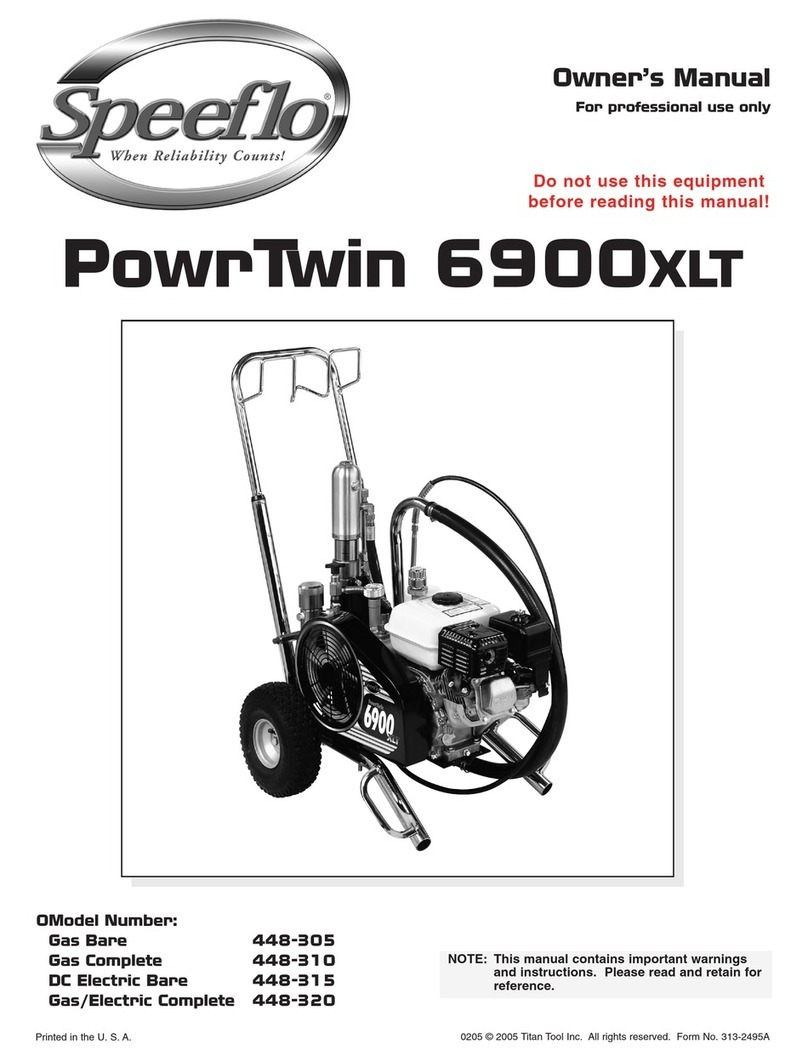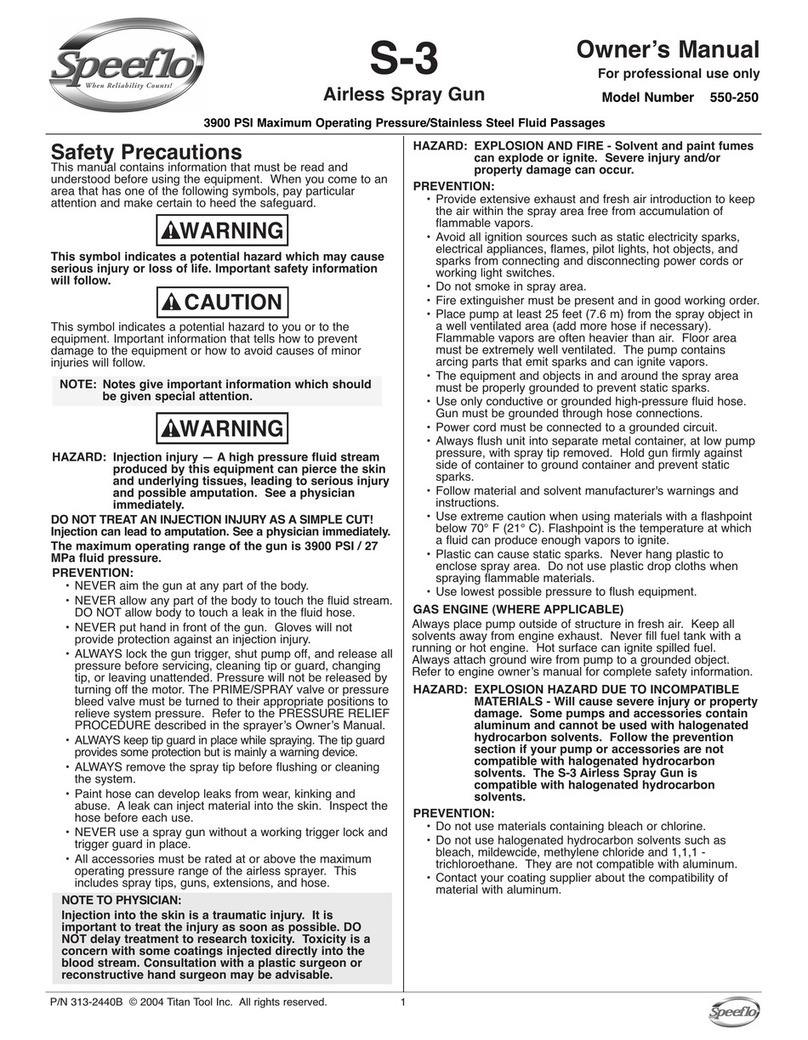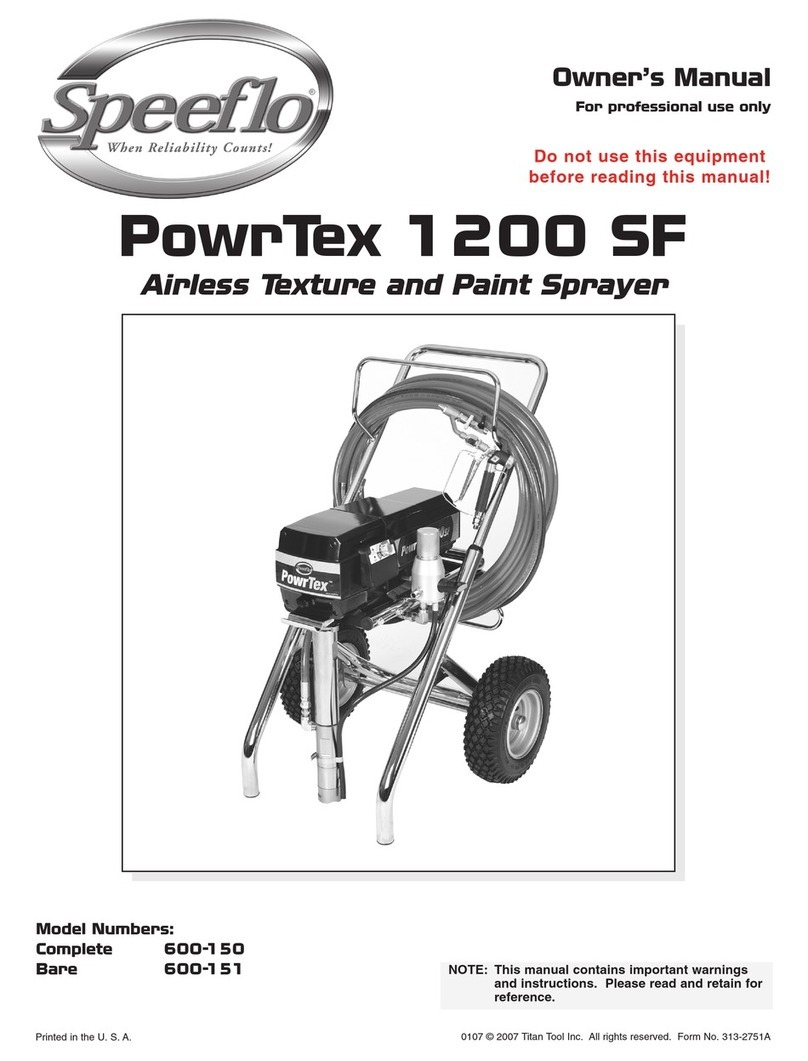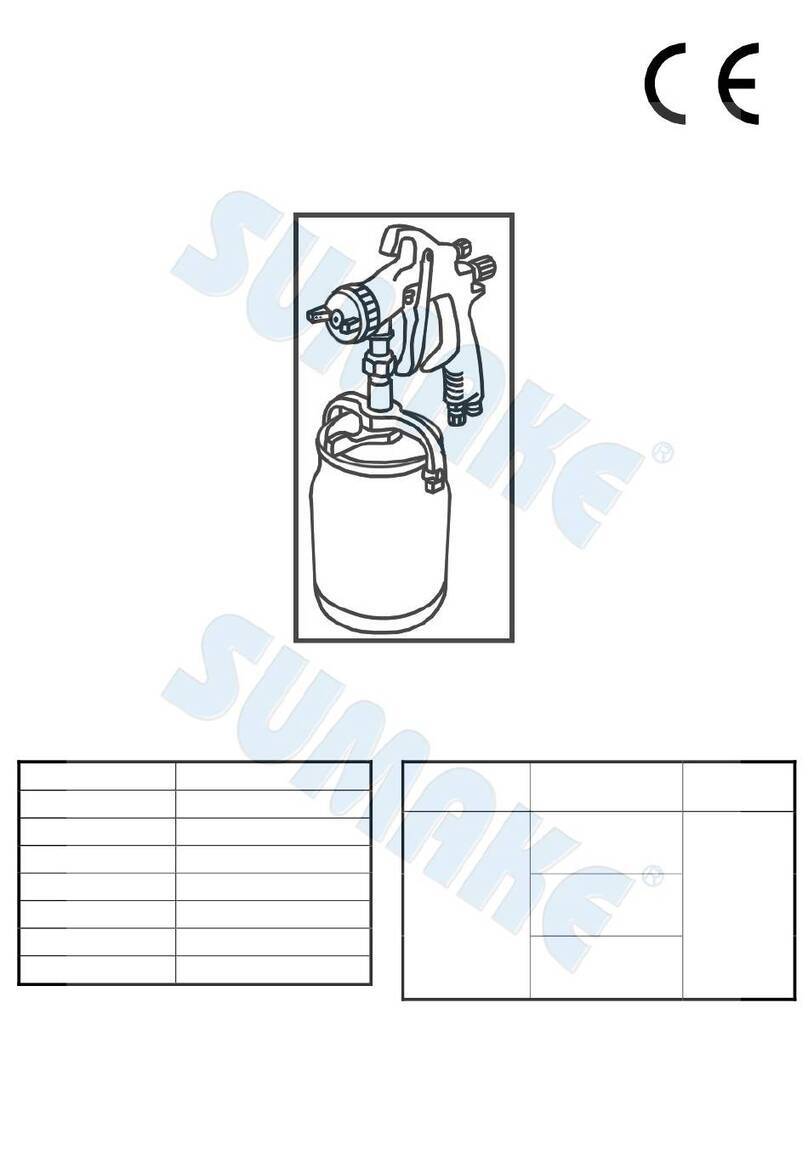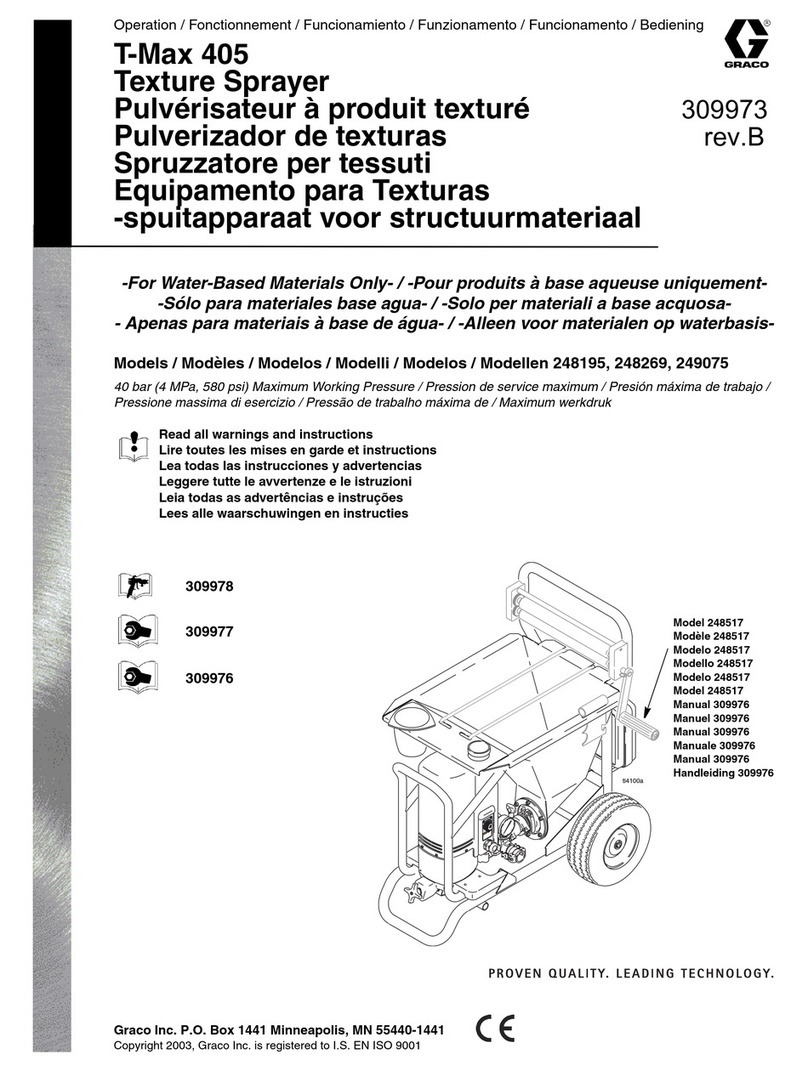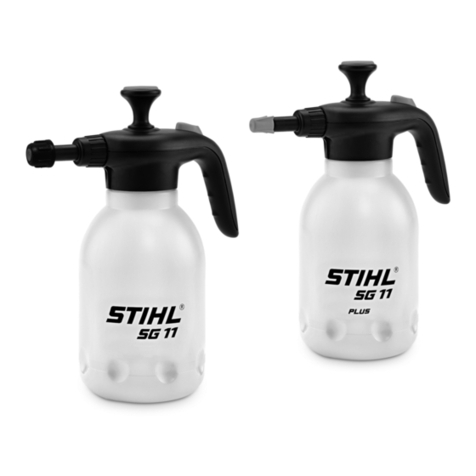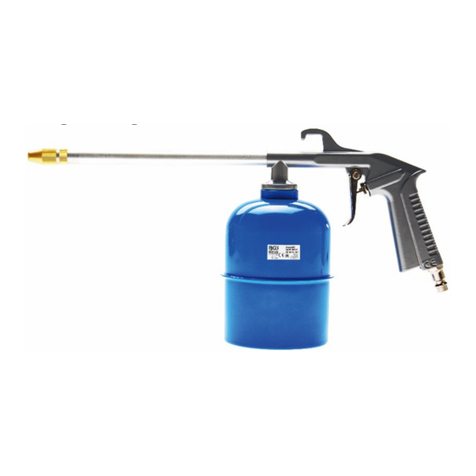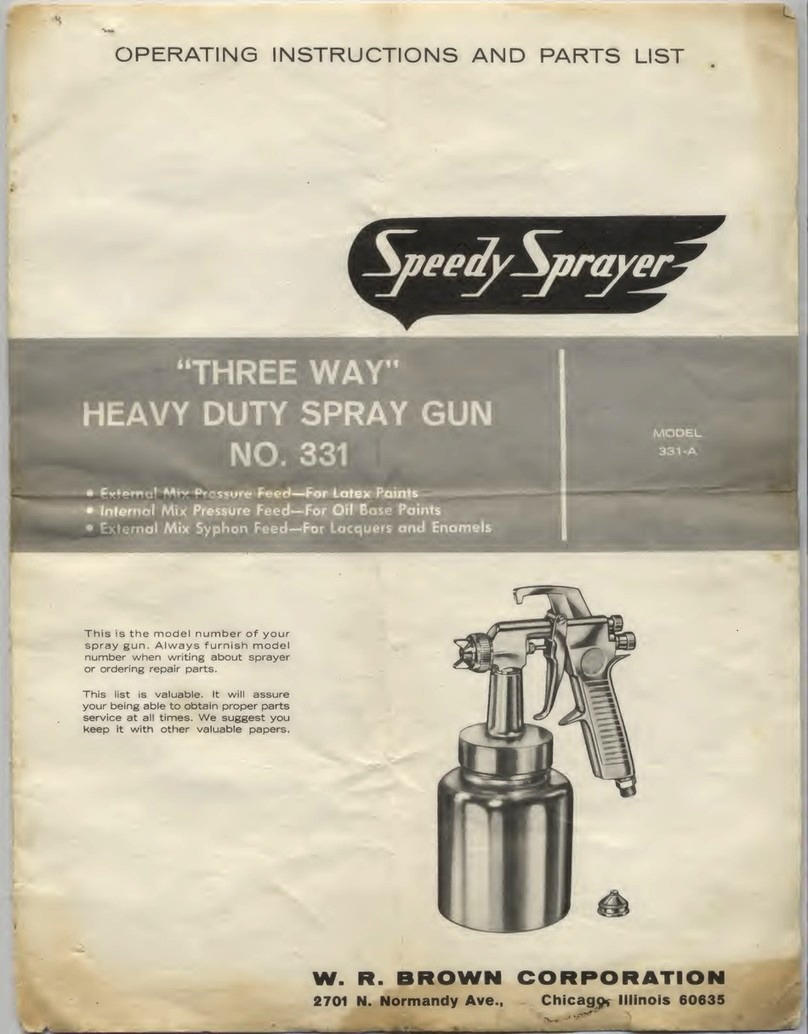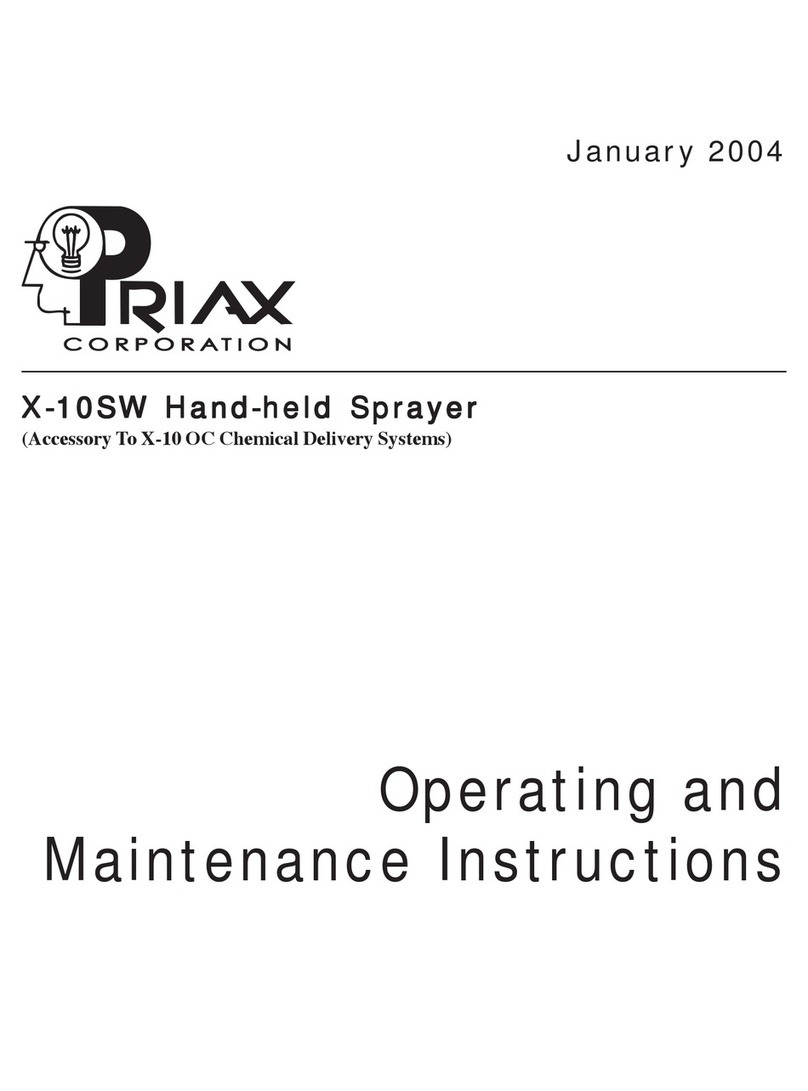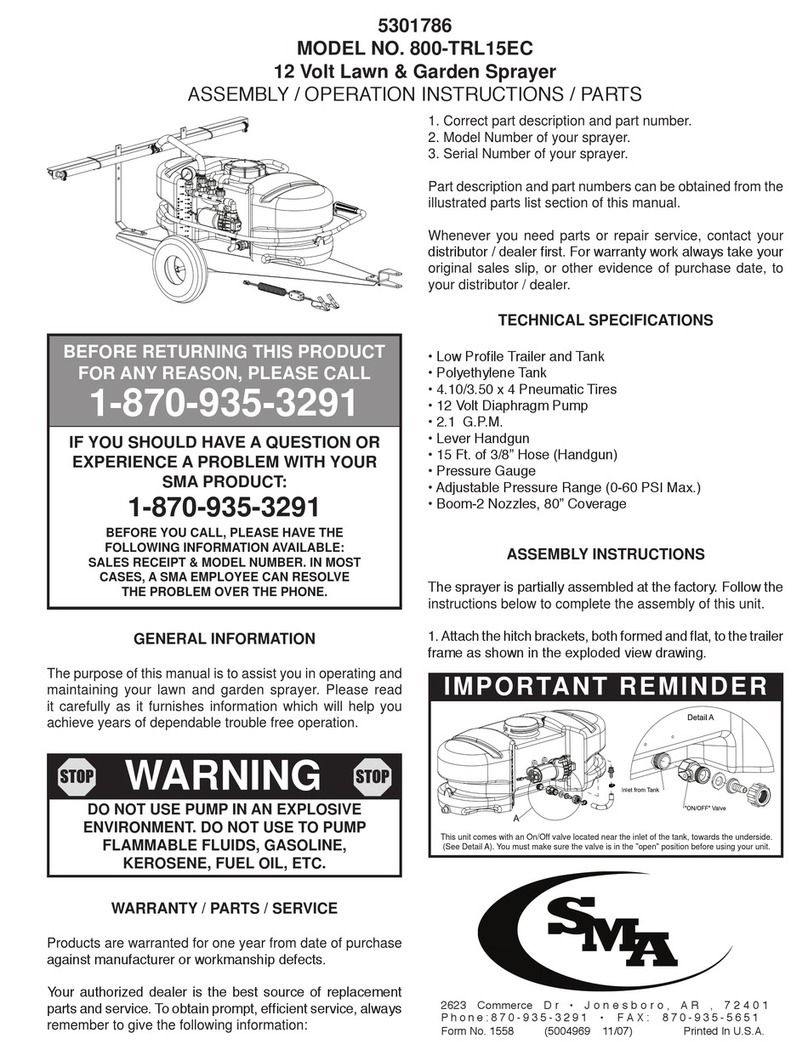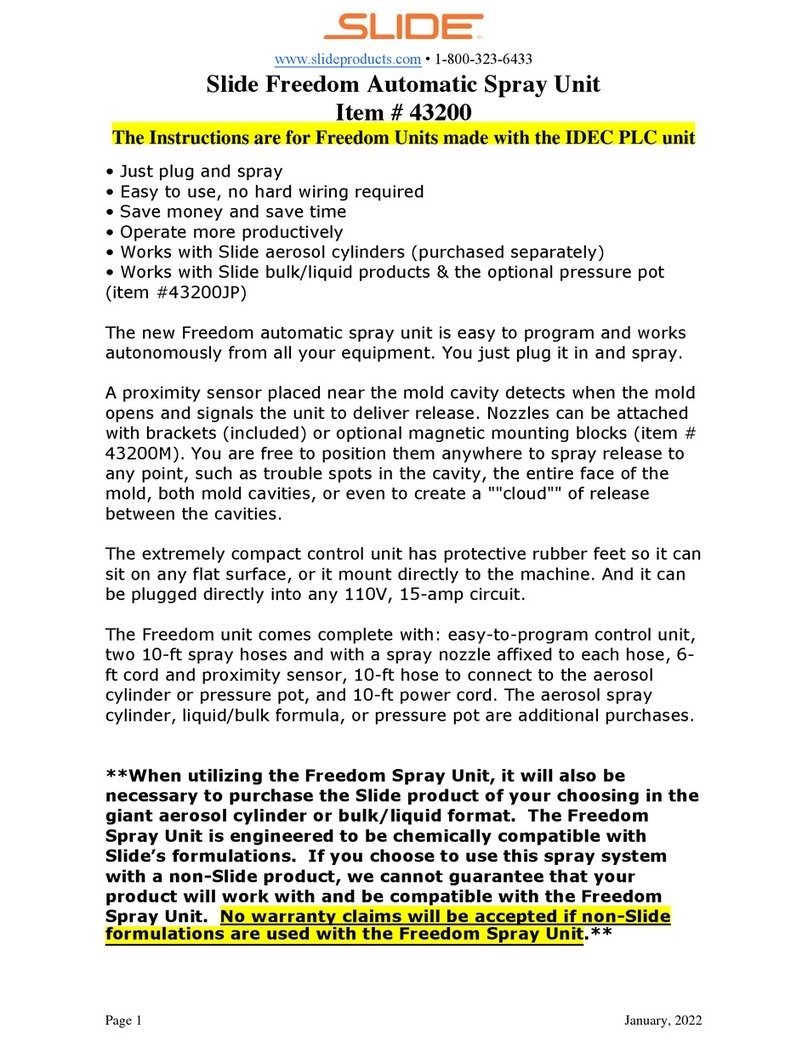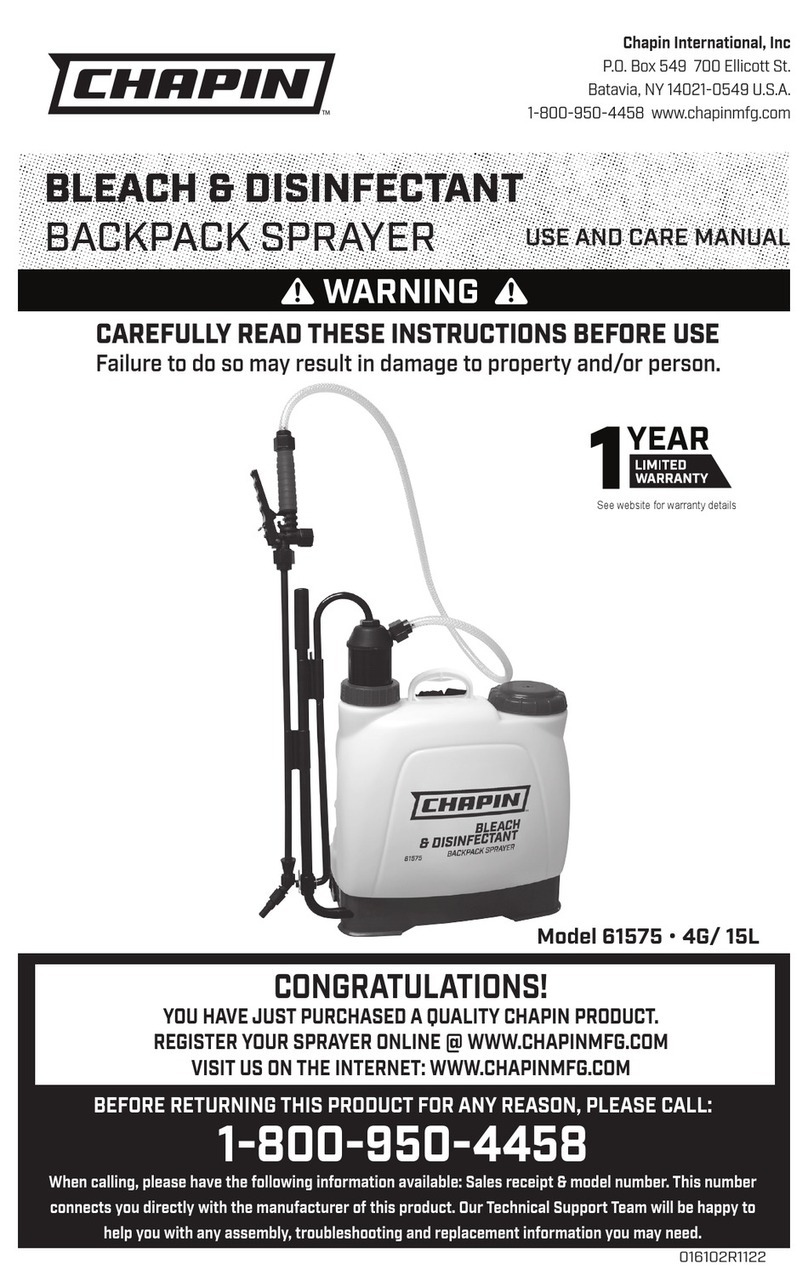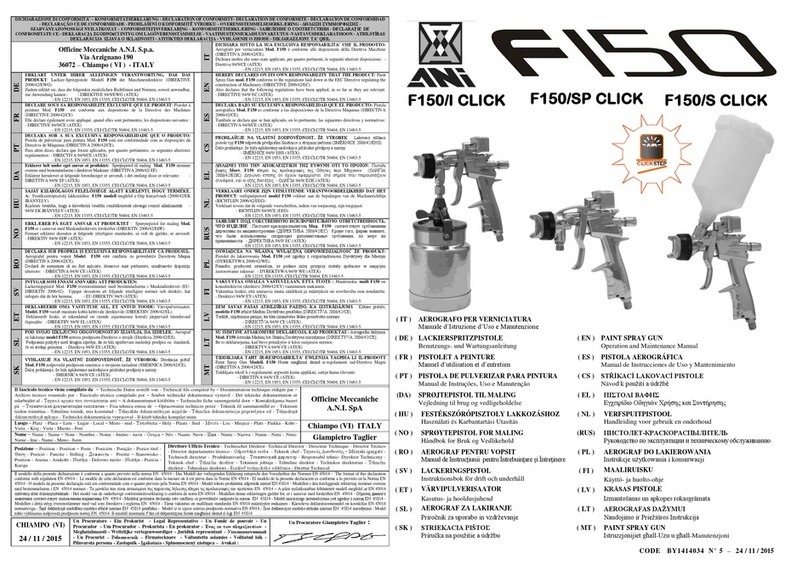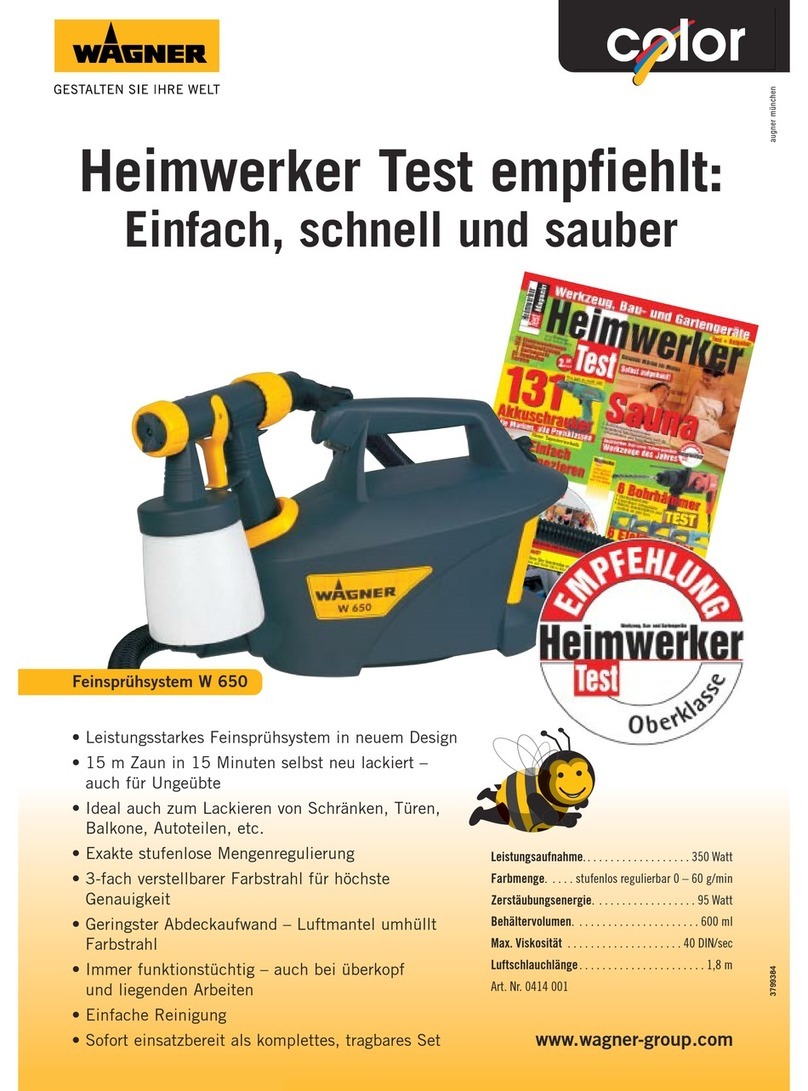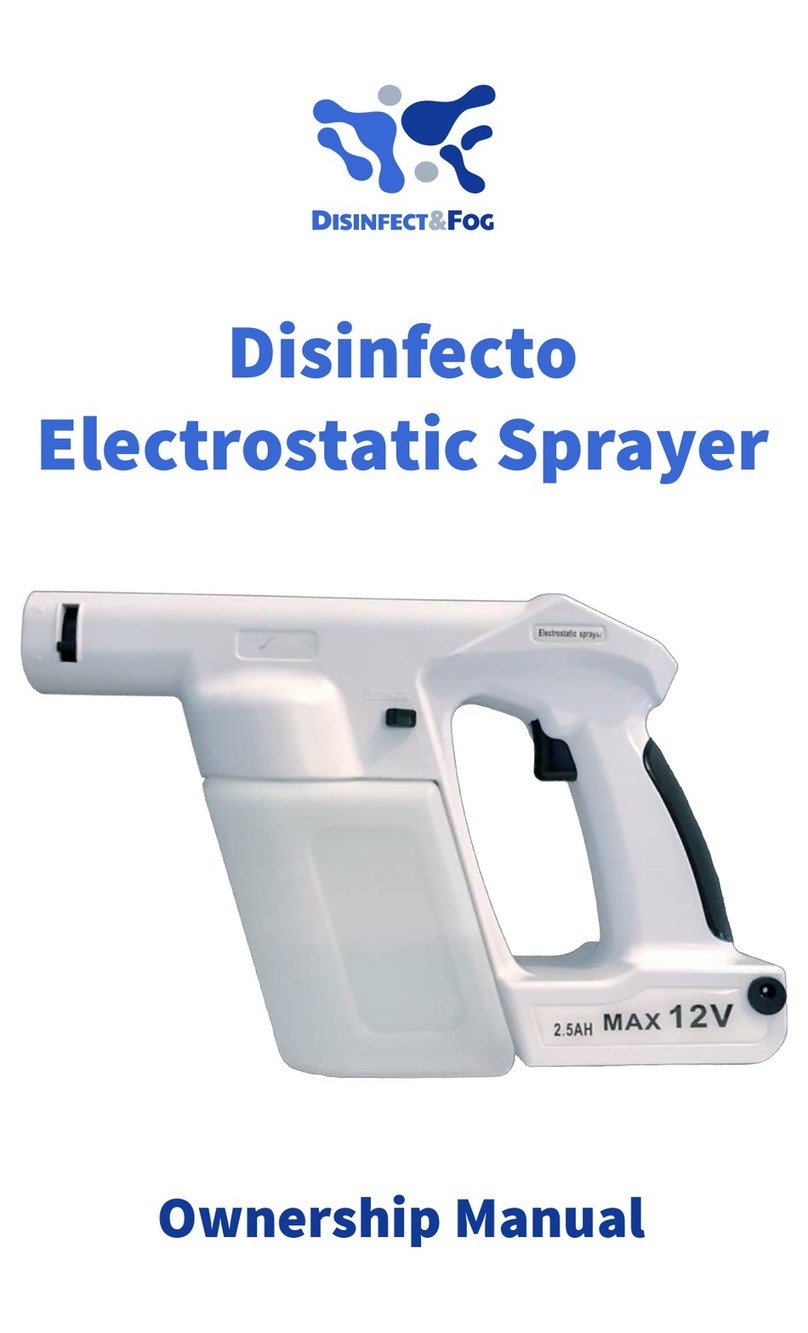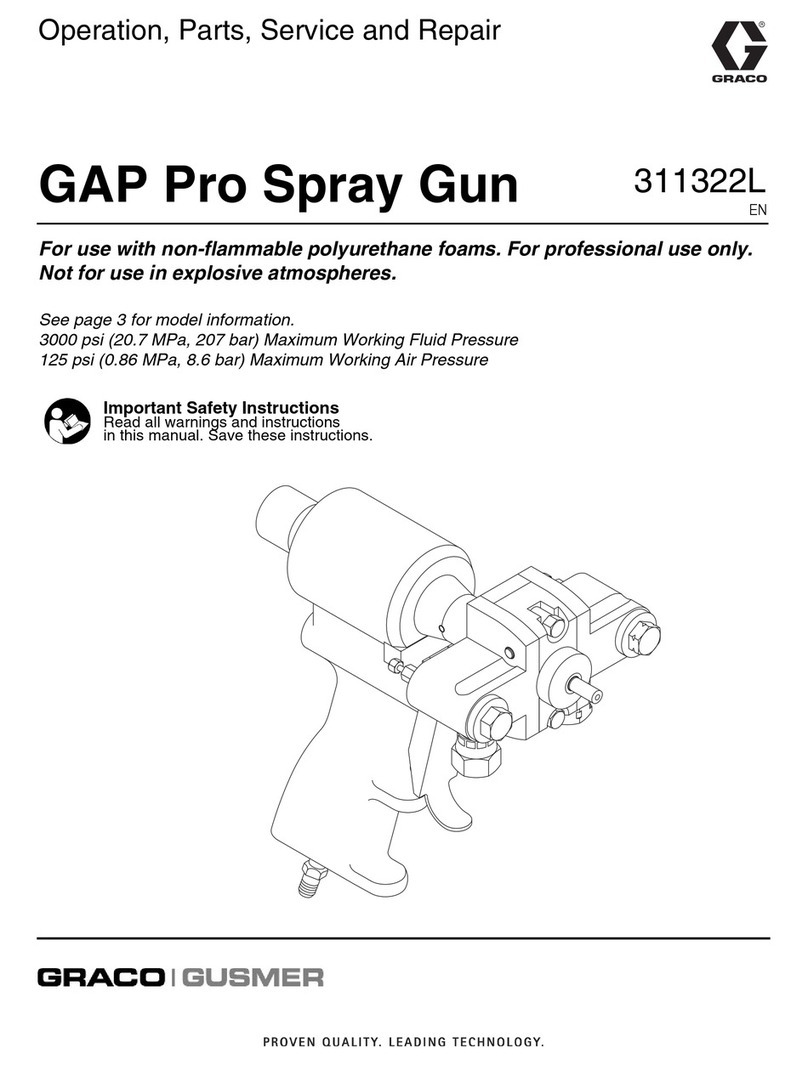Speeflo PowrTwin 3500 User manual

0401 © 2001 Titan Tool Inc. All rights reserved. Form No. 313-1733, REV A
Printed in the U. S. A.
Do not use this equipment before reading this manual!
PowrTwin 3500
50th Anniversary Special
Owner’s Manual
For professional use only
NOTE: This manual contains important warnings
and instructions. Please read and retain for
reference.
Model Number:
Gas Bare 335-5 0

Table of Contents
Introduction. . . . . . . . . . . . . . . . . . . . . . . . . . . . . . . . . . . . . 2
Safety Precautions . . . . . . . . . . . . . . . . . . . . . . . . . . . . . . . 2
Grounding Instructions. . . . . . . . . . . . . . . . . . . . . . . . . . . . 4
Gasoline Engine Safety . . . . . . . . . . . . . . . . . . . . . . . . . . . 4
Français . . . . . . . . . . . . . . . . . . . . . . . . . . . . . . . . . . . . . 14
Español. . . . . . . . . . . . . . . . . . . . . . . . . . . . . . . . . . . . . . 16
Specifications . . . . . . . . . . . . . . . . . . . . . . . . . . . . . . . . . . . 5
Operating Components . . . . . . . . . . . . . . . . . . . . . . . . . . . 6
Setup . . . . . . . . . . . . . . . . . . . . . . . . . . . . . . . . . . . . . . . . . . 7
Fueling . . . . . . . . . . . . . . . . . . . . . . . . . . . . . . . . . . . . . . . . 7
Startup. . . . . . . . . . . . . . . . . . . . . . . . . . . . . . . . . . . . . . . . . 8
Cleanup . . . . . . . . . . . . . . . . . . . . . . . . . . . . . . . . . . . . . . . . 9
Pressure Relief Procedure. . . . . . . . . . . . . . . . . . . . . . . . . 9
Maintenance . . . . . . . . . . . . . . . . . . . . . . . . . . . . . . . . . . . . 9
Troubleshooting . . . . . . . . . . . . . . . . . . . . . . . . . . . . . 11–13
Airless Gun . . . . . . . . . . . . . . . . . . . . . . . . . . . . . . . . . . . 11
Fluid Pumps . . . . . . . . . . . . . . . . . . . . . . . . . . . . . . . . . . 11
Hydraulic Motors . . . . . . . . . . . . . . . . . . . . . . . . . . . . . . . 12
Spray Patterns . . . . . . . . . . . . . . . . . . . . . . . . . . . . . . . . 13
Parts Lists and Service Instructions . . . . . . . . . . . . . 18–31
Main Assembly — Gas Models . . . . . . . . . . . . . . . . . . . . 18
Gas Convertokit. . . . . . . . . . . . . . . . . . . . . . . . . . . . . . . . 19
DC— Electric Convertokit . . . . . . . . . . . . . . . . . . . . . . . . 20
Cart Assembly . . . . . . . . . . . . . . . . . . . . . . . . . . . . . . . . . 22
Hydraulic System . . . . . . . . . . . . . . . . . . . . . . . . . . . . . . 23
Hydraulic Motor . . . . . . . . . . . . . . . . . . . . . . . . . . . . . 24–26
Fluid Pump . . . . . . . . . . . . . . . . . . . . . . . . . . . . . . . . 26–27
Inlet Accessories . . . . . . . . . . . . . . . . . . . . . . . . . . . . . . . 28
Outlet Accessories. . . . . . . . . . . . . . . . . . . . . . . . . . . . . . 29
SAE O-Ring Fitting Installation. . . . . . . . . . . . . . . . . . . . . 31
Key Accessories and Service Kits . . . . . . . . . . . . . . . . . . 31
Airless Tip Selection . . . . . . . . . . . . . . . . . . . . . . . . . . . . 31
Warranty . . . . . . . . . . . . . . . . . . . . . . . . . . . . . . . . . . . . . . 32
Introduction
Congratulations on having selected the finest airless sprayer
available in the world. Speeflo piston pumps are tireless
workhorses — so tough they are virtually indestructible, even
under the most severe service. Speeflo designs and builds
equipment with superior quality and reliability. Equipment that
will last for years with minimal maintenance and downtime.
This equipment will make you money year after year. We
thank you for your purchase and welcome you to our large
and growing family of Speeflo users.
The unique ability of this PowrTwin to operate with either gas
or electric power provides you with the flexibility to work
indoors or outside where no electricity is available.
Hydraulic drive makes possible the longest stroke and slowest
cycling pumps in the industry, which translates into low
maintenance and longer life. Electric units operate quietly with
no motor starting and stopping.
2 © Titan Tool Inc. All rights reserved.
This PowrTwin is equipped with Speeflo's exclusive and
patented Severe Service 500™ fluid pump. This technology
will give you significantly longer rod, cylinder, and packing life
than any other sprayer built in the world. This double ball
piston pump employs a dependable and durable time-tested
design. All pumps use an exclusive thick hard chrome plating
on rod and cylinder parts. This patented plating process is
harder than nitralloy, stainless steel, or hard chrome used by
any other paint pump manufacturer and much more abrasion
resistant. Highly polished parts reduce friction, extend packing
life, and avoid damage from corrosion and abrasion. More
than 100,000 of these pumps are in operation around the
world.
This PowrTwin offers other cost saving features:
• Freeze-proof pressure control
• Choice of power — gas, electric, or both
• Tungsten carbide valve seats
• Self-adjusting packings
• Exclusive hand-tight swivel foot valve
• Large capacity inline paint filter
• Waterborne compatible
• "Floating Ball" pressure bleed valve
• 5 gallon siphon hose and bleed line assemblies are
standard
You have made an excellent choice. We know you will be
pleased with your new PowrTwin. Thanks again for selecting
Speeflo. We appreciate your business.
Warning Labels
Your sprayer has the English
language warning label. If
you require this label in
French, German, or Spanish,
or require additional English
labels, order directly from
Speeflo free of charge.
Safety Precautions
This manual contains information that must be read and
understood before using the equipment. When you come to
an area that has one of the following symbols, pay particular
attention and make certain to heed the safeguard.
This symbol indicates a potential hazard that may cause
serious injury or loss of life. Important safety information
will follow.
This symbol indicates a potential hazard to you or to the
equipment. Important information that tells how to
prevent damage to the equipment or how to avoid causes
of minor injuries will follow.
NOTE: Notes give important information that should
be given special attention.
CAUTION
WARNING
Part # Language
313-771 English
313-784
313-1306 Spanish
313-1307
313-785 French
313-786
313-787 German
313-788

HAZARD: Injection injury - A high pressure stream
produced by this equipment can pierce the
skin and underlying tissues, leading to serious
injury and possible amputation. See a
physician immediately.
DO NOT TREAT AN INJECTION INJURY AS A SIMPLE
CUT! Injection can lead to amputation. See a physician
immediately.
The maximum operating range of the gun is 3300 PSI /
228BAR fluid pressure.
PREVENTION:
• NEVER aim the gun at any part of the body.
• NEVER allow any part of the body to touch the fluid
stream. DO NOT allow body to touch a leak in the fluid
hose.
• NEVER put your hand in front of the gun. Gloves will not
provide protection against an injection injury.
• ALWAYS lock the gun trigger, shut the pump off, and release
all pressure before servicing, cleaning the tip or guard,
changing tip, or leaving unattended. Pressure will not be
released by turning off the motor. The PRIME/SPRAY knob
must be turned to PRIME to relieve the pressure. Refer to
the PRESSURE RELIEF PRESSURE described in the pump
manual.
• ALWAYS keep the tip guard in place while spraying. The
tip guard provides some protection but is mainly a
warning device.
• ALWAYS remove the spray tip before flushing or cleaning
the system.
• The paint hose can develop leaks from wear, kinking and
abuse. A leak can inject material into the skin. Inspect
the hose before each use.
• NEVER use a spray gun without a trigger lock and trigger
guard in place and in good working order.
• All accessories must be rated at or above 3300 PSI / 228
BAR. This includes spray tips, guns, extensions, and
hose.
HAZARD: EXPLOSION OR FIRE - Solvent and paint fumes
can explode or ignite. Severe injury and/or
property damage can occur.
PREVENTION:
• Provide extensive exhaust and fresh air introduction to
keep the air within the spray area free from accumulation
of flammable vapors.
• Avoid all ignition sources such as static electric sparks,
open flames, pilot lights, and hot objects. Connecting or
disconnecting power cords or working light switches can
make sparks.
• Do not smoke in spray area.
• Fire extinguisher must be present and in good working
order.
• Place paint pump in a well ventilated area. Flammable
vapors are often heavier than air. Floor area must be
extremely well ventilated. The paint pump contains arcing
parts that emit spark and can ignite vapors.
• The equipment and objects in and around the spray area
must be properly grounded to prevent static sparks.
• Use only conductive or grounded high pressure fluid hose.
Gun must be grounded through hose connections.
• Power cord must be connected to a grounded circuit
(electric models only).
NOTE TO PHYSICIAN:
Injection into the skin is a traumatic injury. It is
important to treat the injury as soon as possible. DO
NOT delay treatment to research toxicity. Toxicity is a
concern with some coatings injected directly into the
blood stream. Consultation with a plastic surgeon or
reconstructive hand surgeon may be advisable.
WARNING
• Always flush unit into a separate metal container, at low
pump pressure, with spray tip removed. Hold gun firmly
against side of container to ground container and prevent
static sparks.
• Follow the material and solvent manufacturer's warnings
and instructions.
• Use extreme caution when using materials with a
flashpoint below 70° F (21° C). Flashpoint is the
temperature that a fluid can produce enough vapors to
ignite.
• Plastic can cause static sparks. Never hang plastic to
enclose a spray area. Do not use plastic drop cloths
when spraying flammable materials.
• Use lowest possible pressure to flush equipment.
GAS ENGINE (WHERE APPLICABLE)
Always place pump outside of structure in fresh air. Keep all
solvents away from the engine exhaust. Never fill fuel tank
with a running or hot engine. Hot surface can ignite spilled
fuel. Always attach ground wire from pump unit to a grounded
object, such as a metal water pipe. Refer to engine owner’s
manual for complete safety information.
HAZARD: EXPLOSION HAZARD DUE TO INCOMPATIBLE
MATERIALS - Will cause severe injury or
property damage.
PREVENTION:
• Do not use materials containing bleach or chlorine.
• Do not use halogenated hydrocarbon solvents such as
mildewcide, methylene chloride and 1,1,1 -
trichloroethane. They are not compatible with aluminum.
• Contact your coating supplier about the compatibility of
material with aluminum.
HAZARD: HAZARDOUS VAPORS - Paints, solvents,
insecticides, and other materials can be
harmful if inhaled or come in contact with the
body. Vapors can cause severe nausea,
fainting, or poisoning.
PREVENTION:
• Use a respirator or mask if vapors can be inhaled. Read
all instructions supplied with the mask to be sure it will
provide the necessary protection.
• Wear protective eyewear.
• Wear protective clothing as required by coating
manufacturer.
HAZARD: GENERAL - This product can cause severe
injury or property damage.
PREVENTION:
• Read all instructions and safety precautions before
operating equipment.
• Always disconnect the motor from the power supply
before working on the equipment (electric models only).
• Follow all appropriate local, state, and national codes
governing ventilation, fire prevention, and operation.
• The United States Government Safety Standards have
been adopted under the Occupational Safety and Health
Act (OSHA). These standards, particularly part 1910 of
the General Standards and part 1926 of the Construction
Standards should be consulted.
• Use only manufacturer authorized parts. User assumes
all risks and liabilities when using parts that do not meet
the minimum specifications and safety devices of the
pump manufacturer.
• Before each use, check all hoses for cuts, leaks,
abrasion or bulging of cover. Check for damage or
movement of couplings. Immediately replace the hose if
any of these conditions exist. Never repair a paint hose.
Replace it with another grounded high-pressure hose.
• All hoses, swivels, guns, and accessories must be
pressure rated at or above 3300PSI/228 BAR.
• Do not spray outdoors on windy days.
• Wear clothing to keep paint off skin and hair.
© Titan Tool Inc. All rights reserved. 3

Grounding Instructions
Electric models must be grounded. In the event of an
electrical short circuit, grounding reduces the risk of electric
shock by providing an escape wire for the electric current.
This product is equipped with a cord having a grounding wire
with an appropriate grounding plug. The plug must be
plugged into an outlet that is properly installed and grounded
in accordance with all local codes and ordinances.
DANGER — Improper installation of the grounding plug can
result in a risk of electric shock. If repair or replacement of the
cord or plug is necessary, do not connect the green grounding
wire to either flat blade terminal. The wire with insulation
having a green outer surface with or without yellow stripes is
the grounding wire and must be connected to the grounding
pin.
Check with a qualified electrician or serviceman if the
grounding instructions are not completely understood, or if you
are in doubt as to whether the product is properly grounded.
Do not modify the plug provided. If the plug will not fit the
outlet, have the proper outlet installed by a qualified
electrician.
This product is rated more than 15 amperes and is for use on
a circuit having a nominal rating of 120 volts, or the product is
for use on a circuit having a nominal rating more than 120
volts, and is factory-equipped with a specific electric cord and
plug to permit connection to a proper electric circuit. Make
sure that the product is connected to an outlet having the
same configuration as the plug. No adapter should be used
with this product. If the product must be reconnected for use
on a different type of electric circuit, the reconnection should
be made by qualified service personnel.
Use only a 3-wire extension cord that has a 3-blade
grounding plug and a 3-slot receptacle that will accept the
plug on the product. Make sure your extension cord is in
good condition. When using an extension cord, be sure
to use one heavy enough to carry the current your
product will draw. An undersized cord will cause a drop
in line voltage resulting in loss of power and overheating.
For lengths less than 50 feet, No. 12 AWG extension cords
should be used. If an extension cord is to be used
outdoors, it must be marked with the suffix W-A after the
cord type designation. For example, a designation of
SJTW-A would indicate that the cord would be appropriate
for outdoor use.
CAUTION
4 © Titan Tool Inc. All rights reserved.
Gasoline Engine Safety
The engine exhaust from this unit contains chemicals
known to the State of California to cause cancer, birth
defects, or other reproductive harm.
1. Honda engines are designed to give safe and dependable
service if operated according to instructions. Read and
understand the Honda Owner's Manual before operating
the engine. Failure to do so could result in personal injury
or equipment damage.
2. To prevent fire hazards and to provide adequate
ventilation, keep the engine at least 1 meter (3 feet) away
from buildings and other equipment during operation. Do
not place flammable objects close to the engine.
3. Children and pets must be kept away from the area of
operation due to a possibility of burns from hot engine
components or injury from any equipment the engine may
be used to operate.
4. Know how to stop the engine quickly, and understand the
operation of all controls. Never permit anyone to operate
the engine without proper instructions.
5. Gasoline is extremely flammable and is explosive under
certain conditions.
6. Refuel in a well-ventilated area with the engine stopped.
Do not smoke or allow flames or sparks in the refueling
area or where gasoline is stored.
7. Do not overfill the fuel tank. After refueling, make sure
the tank cap is closed properly and securely.
8. Be careful not to spill fuel when refueling. Fuel vapor or
spilled fuel may ignite. If any fuel is spilled, make sure
the area is dry before starting the engine.
9. Never run the engine in an enclosed or confined area.
Exhaust contains poisonous carbon monoxide gas;
exposure may cause loss of consciousness and may lead
to death.
10. The muffler becomes very hot during operation and
remains hot for a while after stopping the engine. Be
careful not to touch the muffler while it is hot. To avoid
severe burns or fire hazards, let the engine cool before
transporting it or storing it indoors.
11. Never ship/transport unit with gasoline in the tank.
DO NOT use this equipment to spray water or acid.
Do not lift by cart handle when loading or unloading.
CAUTION
WARNING
WARNING

© Titan Tool Inc. All rights reserved. 5
Specifications
Gas Units
Delivery (GPM) 1.2
(LPM) 4.5
Cycles per gallon 87
Cycles per liter 23
Cycles per minute (maximum) 104
Maximum Tip Size - 1 Gun .034"
Maximum Tip Size - 2 Guns .025"
Maximum Tip Size - 3 Guns .019"
Pressure Range (psi) 400 - 3300
Pressure Range (bar) 28 - 228
Power Honda 4.0 HP, 4-Stroke,
Single Cylinder, Overhead Valve Engine With Oil Alert
Fuel Capacity 0.66 US Gallons
(Approximately 3 hours run time)
Halogenated Solvent Compatible Yes
Weight 139 Lbs. (63 Kg.)
Inlet Paint Filter 10 Mesh "Rock Catcher"
Outlet Paint Filter 50 Mesh, 18 in.2
Pump Inlet 3/4" NPT(F)
Pump Outlet 1/2" NPT(F) to Paint Filter
Paint Filter Hose Connections (1) - 1/4" NPS(M)
(1) - 3/8" NPT(F) Plugged
Dimensions 30" H (787 mm) x 34" L (864 mm) x 23" W (584 mm)
Fluid Pump Wetted Parts Electroless nickel plated ductile iron, electroless nickel plated carbon steel, propri-
etary Severe Service 500™ hard chrome anti-wear surface, stainless steel, tungsten
carbide, PTFE, thiokol impregnated leather, ultra high molecular weight polyethylene.
Electric Units
DC - Electric
Delivery (GPM) 1.10
(LPM) 4.20
Cycles per gallon 87
Cycles per liter 23
Cycles per minute (maximum) 96
Maximum Tip Size - 1 Gun .031"
Maximum Tip Size - 2 Guns .023"
Maximum Tip Size - 3 Guns .017"
Pressure Range (psi) 400 - 3300
Pressure Range (bar) 28 - 228
Power 2 HP DC Motor
115V, 16 AMP
230V, 8 AMP
Overload Protected
Halogenated Solvent Compatible Yes
Weight 158 Lbs. (72 Kg.)
Inlet Paint Filter 10 Mesh "Rock Catcher"
Outlet Paint Filter 50 Mesh, 18 in.2
Pump Inlet 3/4" NPT(F)
Pump Outlet 1/2" NPT(F) to Paint Filter
Paint Filter Hose Connections (1) - 1/4" NPS(M)
(1) - 3/8" NPT(F) Plugged
Dimensions 30" H (787 mm) x 34" L (864 mm) x 23" W (584 mm)
Fluid Pump Wetted Parts Electroless nickel plated ductile iron, electroless nickel plated carbon steel, propri-
etary Severe Service 500™ hard chrome anti-wear surface, stainless steel, tungsten
carbide, PTFE, thiokol impregnated leather, ultra high molecular weight polyethylene.

6 © Titan Tool Inc. All rights reserved.
Bleed Line
Siphon Hose
Hydraulic Filter
Muffler
Hydraulic Fluid
Fill and Dipstick
Hydraulic
Bypass Valve
Choke
Engine ON/OFF
Switch
Hydraulic
Reservoir
Grounding Lug
Hydraulic Return
Hose
Hydraulic
Pressure Hose
Siphon Hose
Fluid Pump
Pressure
Adjustment
Knob
Hydraulic Motor
Paint Filter
Connecting Pin
Hydraulic
Shut-Off
Valve
Wet Cup
Snap Down
Handle Buttons
Hose Rack
Operating Components

Setup
Read, understand, and follow all warnings before starting
or operating this sprayer.
1. Connecting the Hoses:
The siphon hose and the bleed line hose have factory
installed PTFE tape on the male end of the hoses.
Tighten the syphon hose and bleed line wrench tight.
2. One Gun Operation - Attach the gun and hose. Always
use a spray hose at least 50 feet long. Do not use PTFE
or thread sealant on this assembly. Do not install the
spray tip at this time.
3. Two Gun Operation - Remove the plug from the second
gun outlet. Connect a hose and a gun to the outlet.
4. Multiple Gun Operation - This unit is engineered to handle
up to 3 guns with .019" tips. When using more than two
guns, make sure the second gun hookup outlet is
plugged. Connect the multiple gun manifold to the single
gun outlet. These manifolds are for either 2, 3, or 4-guns
and have shut off valves. Connect a hose and gun to
each outlet.
5. Fill the wet-cup 1/2 full with Speeflo Piston Lube (P/N 700-
925) supplied by the factory. This extends packing life.
6. Electric Models - Use a 20 amp service outlet. Always
locate the electric model within 10 to 15 feet of the service
outlet. Use a short electric cable and a long paint hose.
Any extension cord will create some voltage drop. If an
extension cord is necessary, use only grounded 3 wire #
12 extension cords.
Siphon Hose
Bleed Line
Connection
WARNING
If the unit is being operated in an area that is overloaded
by other appliances or low voltage conditions, it is
important to start the unit "unloaded." Tip the electric
motor forward so that the belt is loosened and the motor
starts without full load. This reduces the amperage draw
on starting and may avoid tripping the circuit breaker.
7. Be sure the PowrTwin system is grounded. All Speeflo
units are equipped with a grounding lug. A grounding
cable (not supplied) should be used to connect the unit to
a true earth ground. Check your local electrical
regulations for detailed grounding instructions. See the
Accessories and Service Kits section near the back of this
manual for ordering information.
8. Strain all paints with a nylon strainer to ensure trouble free
operation and freedom from frequent cleaning of the inlet
screen and gun strainer.
Proper grounding is important. This applies to both gas
and electric powered models. The passage of some
materials through the nylon fluid hose will build up a
static electric charge, which if discharged, could ignite
solvent vapors present and create an explosion.
Fueling
Gasoline is extremely flammable and is explosive under
certain conditions.
•ALWAYS turn the engine off before refueling.
•Refuel in a well-ventilated area.
•Do not smoke or allow flames or sparks in the refueling
area or where gasoline is stored.
•Do not overfill the fuel tank. After refueling, make sure the
tank cap is closed properly and securely.
•Be careful not to spill fuel when refueling. Spilled fuel or
fuel vapor may ignite. If any fuel is spilled, make sure the
area is dry before starting the engine.
•Avoid repeated or prolonged contact with skin or breathing
of vapor.
•Keep out of the reach of children.
Fuel Specifications
•Use automotive gasoline that has a pump octane number
of 86 or higher, or that has a research octane number of
91 or higher.
•Unleaded fuel produces fewer engine and spark plug
deposits and extends the life of exhaust system
components.
•Never use stale or contaminated gasoline or an
oil/gasoline mixture. Avoid getting dirt, dust or water in the
fuel tank. Use of a lower octane gasoline can cause
persistent "pinging" or heavy "spark knock" (a metallic
rapping noise) which, if severe, can lead to engine
damage.
NOTE: If "spark knock" or "pinging" occurs at a
steady engine speed under normal load,
change brands of gasoline. If spark knock or
pinging persists, consult your authorized
Honda dealer. Failure to do so is considered
misuse, and damage caused by misuse is not
covered by the engine manufacturer’s limited
warranty.
Occasionally you may experience light spark
knock while operating under heavy loads. This
is no cause for concern, it simply means your
engine is operating efficiently.
WARNING
WARNING
© Titan Tool Inc. All rights reserved. 7

Gasolines Containing Alcohol
If you decide to use a gasoline containing alcohol (gasohol),
be sure its octane rating is at least as high as that
recommended by the engine manufacturer. There are two
types of "gasohol": one containing ethanol, and the other
containing methanol. Do not use gasohol that contains more
than 10% ethanol. Do not use gasoline containing methanol
(methyl or wood alcohol) that does not also contain co-
solvents and corrosion inhibitors for methanol. Never use
gasoline containing more than 5% methanol, even if it has co-
solvents and corrosion inhibitors.
Startup
1. Areas must be well ventilated to prevent hazardous
operation with volatile solvents or exhaust fumes.
If lacquer or other flammable materials are to be sprayed,
ALWAYS locate the unit outside the immediate spraying
area. Failure to do so may cause an explosion.
2. Locate the unit outside the immediate spraying area to
avoid clogged air intake of the engine or electric motor
with overspray.
3. Before starting the unit. check oil levels.
a. The hydraulic fluid level should read "Full" on the
dipstick. CHECK IT REGULARLY. See “Hydraulic
System”in the Maintenance section of this manual for
changing or adding hydraulic fluid. Do not overfill. Use
only Speeflo Coolflo™Hydraulic Fluid (P/N 430-361).
b. The gasoline engine oil level is determined by the
manufacturer. Check the manufacturer's service
manual supplied.
Use of Speeflo's Coolflo™Hydraulic Fluid is mandatory in
the PowrTwin hydraulic system. Do not use any other
hydraulic fluid. Use of any other hydraulic fluid may
seriously damage hydraulic system and will void warranty.
4. Open the orange-handled hydraulic shut-off valve located on
the hydraulic pressure hose. The handle should be in line
with the hose. The figure below shows the handle in the
open position.
CAUTION
WARNING
NOTE: Fuel system damage or engine performance
problems resulting from the use of fuels that
contain alcohol is not covered under the
warranty. The engine manufacturer cannot
endorse the use of fuels containing methanol
since evidence of their suitability is incomplete
at this time.
Before buying gasoline from an unfamiliar
station, try to find out if the gasoline contains
alcohol. If it does, confirm the type and
percentage of alcohol used. If you notice any
undesirable operating characteristics while
using a gasoline that contains alcohol, or one
that you think contains alcohol, switch to a
gasoline that you know does not contain
alcohol.
8 © Titan Tool Inc. All rights reserved.
5. Turn the pressure control knob counterclockwise (as
viewed from top) to its lowest pressure setting.
6. Open the pressure bleed valve by turning it
counterclockwise. This relieves pressure.
a. Your new sprayer was tested at the factory with mineral
spirits. You must clean the system before spraying to
avoid contamination of the sprayed material.
If you are spraying a water based latex, flush with
warm, soapy water followed by a clean water rinse. If
you are using any other coating, flush with warm, soapy
water followed by a solvent. Check with the material
manufacturer for a compatible solvent. Place syphon
tube assembly into proper solvent or water.
b. Place waste container below bleed line.
c. Start engine or electric motor. Turn the pressure
control adjustment knob clockwise (increasing
pressure) until pump cycles evenly and solvent flows
freely from bleed line.
d. Close the pressure bleed valve by turning it clockwise.
This allows the system to pressurize. Hold the gun
trigger open, without spray tip attached, until the fluid
flows smoothly.
7. Repeat above starting procedure with paint material. Lock
gun trigger and attach spray tip. Refer to the spray gun’s
Technical Data Sheet or Owner's Manual for tip installation
and selection of the proper tip size.
8. Test spray pattern. Operate the pump at the lowest
hydraulic pressure which provides good atomization. See
the Troubleshooting section in this manual if you are not
getting the proper pattern.
9. Operating pressure is adjustable from 400 to 3300 psi
(228 bar) by turning the pressure control knob clockwise.
Do not turn the knob clockwise more than necessary to
provide satisfactory atomization. Excess pressure wears
out spray tips.
10. When restarting the unit, reduce the pressure at the
pressure control adjustment knob and the pressure bleed
valve.
Pressure Bleed
Valve
Pressure Control
Knob
Shut-Off Valve

Cleanup
Special cleanup instructions for use with flammable
solvents:
•Always flush spray gun preferably outside and at
least one hose length from spray pump.
•If collecting flushed solvents in a one gallon metal
container, place it into an empty five gallon metal
container, then flush solvents.
•Area must be free of flammable vapors.
•Follow all cleanup instructions.
Pressure Relief Procedure
Always reduce pressure when you are cleaning a clogged
tip, changing a tip, servicing any part of the system, or
shutting down. Follow the steps below:
1. Engage the gun trigger lock.
2. Shut off the power source.
3. Close the orange-handled hydraulic shut-off valve on the
hydraulic pressure hose.
4. Open the pressure bleed valve by turning it
counterclockwise at least three full turns.
5. Disengage the gun trigger lock and hold trigger open until
flow of material stops.
6. Be certain to hold a metal part of the gun firmly to the side
of a grounded metal container.
Cleaning a Clogged Tip
1. Follow the “Pressure Relief Procedure”above.
2. If tip clogs, rotate tip handle 180°until arrow on handle is
facing the opposite of spray direction and clicks in reverse
position.
3. Trigger gun once so that the pressure can blow the clog
out. NEVER use the tip in the reverse position for more
than ONE trigger pull at a time. This procedure can be
repeated until the tip is free of clogging.
The flow from the spray tip is at very high pressure.
Contact with any body part may be dangerous. Do not
place finger on gun outlet. Do not point the gun at any
person. Never operate the spray gun without the proper
tip guard.
WARNING
WARNING
WARNING
Color Change/Clean Out
Use only compatible solvents when cleaning out oil based
enamels, lacquers, coal tar, and epoxies. Check with the
fluid manufacturer for the recommended solvent.
1. Reduce pressure by turning the pressure control knob and
the pressure bleed valve on the bleed line
counterclockwise. Follow the “Pressure Relief Procedure”
above. The pressure bleed valve should be turned
counterclockwise at least three full turns.
2. Pull the siphon tube out of the material container.
3. Remove the spray tip from the gun. Hold the gun trigger
open until material flow stops.
4. Put the siphon tube into wash solvent or water as
applicable, and operate the pump slowly at low pressure
until solvent flows freely from the bleed line.
5. Close the pressure bleed valve and hold the gun trigger
open until solvent flows freely from the gun. If solvent is
not too dirty, recirculate it by flowing the gun stream back
into the solvent container. Use additional clean solvent
and repeat procedure, if necessary.
6. Check the gun filter and pump outlet filter screen daily.
Use 50 mesh screens with spray tip size .018 and larger.
Use 100 or 200 mesh screens with spray tip sizes .015
and smaller.
7. Replace the paint filter cap to maximum clockwise
rotation. The filter cover should be hand removable after
the first or second use with new PTFE o-ring.
IMPORTANT: The o-ring must have the PTFE backup
washer to seal properly.
8. If the unit has been spraying a water soluble material,
flush with water and then repeat procedure with mineral
spirits or Varsol solvent.
9. Wash the spray tip in solvent. Blow the tip clean with air
pressure directed through the tip in the reverse direction.
Pressure Bleed
Valve
CAUTION
© Titan Tool Inc. All rights reserved. 9

Maintenance
Hydraulic System
Use of Speeflo's Coolflo™Hydraulic Fluid is mandatory in
the PowrTwin hydraulic system. Do not use any other
hydraulic fluid. Use of any other hydraulic fluid may
seriously damage hydraulic system and will void warranty.
1. Check the hydraulic fluid daily. It should read "Full" on the
dipstick. If it is low, add only Speeflo Coolflo™Hydraulic Fluid
(P/N 430-361). Never add or change hydraulic fluid except in
a clean dust free area. Contamination of the hydraulic fluid
will shorten hydraulic pump life and may void warranty.
2. Change the hydraulic fluid every twelve months. Drain the
old fluid from the tank and fill with 5 quarts of Speeflo
Coolflo™Hydraulic Fluid. Start operation of the unit at
just enough pressure to operate the fluid pump. Run the
unit at this low pressure for at least 5 minutes. This
removes air from the system. Check the the fluid level
after this procedure.
3. The hydraulic system has an external replaceable
hydraulic filter. Change the filter every twelve months.
4. The hydraulic pump should not be serviced in the field. If
service on the hydraulic pump is required, it must be
returned to Speeflo.
General Fluid Pump Maintenance
If the paint pump is going to be out of service for an extended
period of time, it is recommended that following cleanup a
kerosene and oil mixture be introduced as a preservative.
Packings may tend to dry out from lack of use. This is
particularly true of the upper packing set for which upper
packing lubricant Piston Lube (P/N 700-925) is recommended
in normal usage.
If the paint pump has been out of service for an extended
period of time, it may be necessary to prime the suction by
pouring some of the paint solvent into the inlet siphon tube to
restart. It is extremely important that the threads on the inlet
siphon hose coupling are properly sealed. Any air leakage will
produce erratic operation of pump and may damage the
system. The up and the down strokes should be approximately
equal in time. That is, one should not be faster than the other. A
fast up or down stroke may indicate air in the system or
malfunctioning valve or seats. See the Troubleshooting section.
Hydraulic Motor and Fluid Pump
Service
See the Hydraulic Motor Service Instructions section near the
back of this manual for maintenance and service instructions
on the reciprocating hydraulic motor.
See the Fluid Pump Service Instructions section near the back
of this manual for maintenance and service instructions on the
fluid pump.
Hydraulic Fluid
Fill and Dipstick
CAUTION
10 © Titan Tool Inc. All rights reserved.
Basic Engine Maintenance
•For detailed engine maintenance and technical
specifications refer to the separate Honda engine manual.
•All service to the engine should be performed by an
authorized Honda Power Equipment dealer. To locate a
dealer in your area, look in the Yellow Pages of your
telephone directory under Gasoline Engines, Garden &
Lawn Equipment & Supplies, Lawn Mowers, etc.
•The Honda engine is warranted exclusively by American
Honda Motor Co., Inc.
•Use a premium quality motor oil certified to meet or
exceed U.S. Automotive requirement SG.SF/CC.CD. SAE
10W30 is recommended for general all temperature use.
Other viscosities may be required in other climates.
•Use only a (NGK) BP6ES or BPR6E spark plug. Gap the
plug to 0.028 to 0.031 In. (0.7 to 0.8 mm) Always use a
spark plug wrench.
DAILY: Check engine oil level. Fill as necessary. Check
gasoline level. Fill as necessary.
Always follow the fueling procedure outlined earlier in this
manual.
FIRST 20 HOURS: Change engine oil.
EVERY 100 HOURS: Change engine oil.
WEEKLY: Remove the air filter cover and clean the element.
In very dusty environments, check the filter daily. Replace the
element as needed. Replacement elements can be purchased
from your local Honda dealer.
Engine Operation and Service
1. Clean and oil air filter pad on gasoline engine every 25
hours or once weekly. Do not permit the air intake screen
around the fly wheel of the gas engine to load up with
paint or trash. Clean it regularly. The service life and
efficiency of the gas engine model depends upon keeping
the gasoline engine running properly. Change the oil in
the engine every 100 hours. Failure to observe this may
result in engine overheating. Consult the engine
manufacturer's service manual provided.
2. To conserve fuel, service life, and efficiency of the unit,
always operate the gasoline engine at the lowest RPM at
which it runs smoothly without laboring and delivers the
amount required for the particular painting operation.
Higher RPM does not produce higher working pressure.
The gasoline engine is connected to the hydraulic pump
by a pulley combination designed to produce full paint
delivery of 1.2 GPM at maximum RPM.
3. The warranty on gasoline engines or electric motors is
limited to the original manufacturer.
If electric motor overloads and stops running,
IMMEDIATELY turn the motor off and follow the Pressure
Relief Procedure in the Cleanup section of this manual.
Wait until the motor cools (approximately 30 minutes).
Then push in the bubble top, manual reset button, turn the
motor on and pressurize the system.
For CSA approved units only: The ON/OFF switch is also
the RESET!
WARNING
WARNING

© Titan Tool Inc. All rights reserved. 11
Troubleshooting
Airless Gun
Problem
Spitting gun
Gun will not shut off
Gun does not spray
Fluid Section
Problem
Pump delivers on upstroke
only or goes up slowly and
down fast (commonly called
downstroke dive)
Pump delivers on down stroke
only or goes up fast and down
slowly
Pump moves up and down
fast, delivering material
Pump moves up and down
slowly when spray gun is shut
off
Not enough fluid pressure at
gun
Pump chatters on up or down
stroke
Cause
1. Air in system
2. Dirty gun
3. Needle assembly out of adjustment
4. Broken or chipped seat
1. Worn or broken needle & seat
2. Needle assembly out of adjustment
3. Dirty gun
1. No paint
2. Plugged filter or tip
3. Broken needle in gun
Cause
1. Lower foot valve ball is not seating due
to trash or wear
2. Material too viscous to siphon.
3. Air leaking in on siphon side or
damaged siphon hose. Siphon may be
too small for heavy material.
1. Upper ball is not seating due to trash or
wear
2. Lower packing set is worn
1. Material container is empty or material
is too thick to flow through siphon hose
2. Bottom ball stuck to foot valve seat
3. Siphon hose is kinked or loose
1. Loose connections. Bleed valve is open
partially or bleed valve is worn. Lower
packing seat is worn.
2. Upper and/or lower ball not seating
1. Spray tip is worn
2. Outlet filter or gun filter is clogged
3. Low voltage and/or inadequate
amperage
4. Hose size or length is too small or too
long
1. Solvent has caused upper packing to
swell
Solution
1. Inspect connections for air leaks.
2. Disassemble and clean.
3. Inspect and adjust.
4. Inspect and replace.
1. Replace.
2. Adjust.
3. Clean.
1. Check fluid supply.
2. Clean.
3. Replace.
Solution
1. Remove foot valve assembly. Clean and
inspect. Test foot valve by filling with water;
if ball fails to seal the seat, replace ball.
2. Thin material —contact manufacturer for
proper thinning procedures.
3. Tighten all connections between pump and
paint container. If damaged, replace. Switch
to larger diameter siphon set.
1. Check upper seat and ball with water. If ball
fails to seal, replace seat.
2. Replace packing set if worn.
1. Refill with new material. If too thick, remove
siphon hose, immerse fluid section in
material, and start pump to prime. Add
thinner to material. Change to bigger
siphon set. Open bleed valve to remove
air and restart pump.
2. Remove foot valve. Clean ball and seat.
3. Straighten.
1. Check all connections between pump and
gun. Tighten as necessary. If material is
flowing from bleed hose, close bleed valve
or replace, if necessary. Should none of the
above be evident, replace lower packing.
2. Reseat balls by cleaning.
1. Replace.
2. Clean or replace filter.
3. Check electrical service. Correct as
required.
4. Increase hose size to minimize pressure
drop through hose and/or reduce hose
length.
1. Replace packing.

Hydraulic Motors
Problem
Oil motor stalls at bottom (no
unusual heat problems)
Oil motor stalls at top (no
unusual heat problems)
Low pressure (okay on down
stroke, sluggish on up.stroke —
high heat)
NOTE: Engine labors on
upstroke, idles back
at stall on the down
stroke.
Low pressure (both strokes -
high heat)
NOTE: Engine labors at stall
on both strokes.
Cause
1. Fluid pump piston seat unthreaded
2. Valve sticking or oil motor trip rod
shifter assembly separated
1. Valve sticking
2. Broken spring retainer (valve rod
assembly)
3. Broken spring or valve rod
4. Air in hydraulic motor
5. Air in fluid pump
1. Blown piston seal
2. Cracked piston
1. Blown center o-rings on spool valve
2. Bad hydraulic pump
Solution
1. If connecting rod is okay, remove cylinder
head plug and pop valve down. Replace
plug and start machine. If machine cycles
up and stops at bottom again, then problem
is piston seat on fluid pump. Check piston
seat. Repair or replace as necessary. If
piston seat is okay and problem does not
change, check oil motor.
2. Remove valve and check for scratches and
rough movement when sliding it up and
down. Replace valve and spool in this
condition. Check trip rod for possible
separation.and spool in this condition.
Check trip rod for possible separation.
1. Remove valve and check for scratches and
rough movement when sliding it up and
down. Replace valve and spool in this
condition.
2. Replace valve rod assembly.
3. Replace valve rod assembly.
4. Reset valve. Purge Air, generally
accomplished by low pressure cycling of
motor/pump assembly for 5–10 minutes.
Check for causes of air introduction:
•Loose fittings in tank.
•Loose fittings on hydraulic pump.
•Loose hose connections.
•Low oil in reservoir.
5. Stall at top can occur randomly when fluid
pump picks up air. Reset valve. Avoid air in
the fluid pump.
1. Before dismantling oil motor, start machine.
With pump cycling under pressure, touch
the hydraulic cylinder and the head to see if
cylinder or head gets hotter. This will help
determine if piston seal is blown or piston
nut is broken. If heat is on the head, check
the o-rings on spool valve.
2. Dismantle oil motor and check piston seals
cylinder bore and piston nut. Pay special
attention to piston nut. It can be cracked
and not show externally.
1. Before dismantling oil motor, start machine.
With pump cycling under pressure, touch
the head to see if the head becomes hotter.
This will help determine if center o-ring is
blown on spool valve. If hot, remove and
replace o-ring.
2. Replace hydraulic pump.
Troubleshooting
12 © Titan Tool Inc. All rights reserved.

© Titan Tool Inc. All rights reserved. 13
Troubleshooting
Spray Patterns
Problem
Tails
Hour glass
Distorted
Pattern expanding and
contracting (surge)
Round pattern
Cause
1. Inadequate fluid delivery
1. Inadequate fluid delivery
1. Plugged or worn nozzle tip
1. Suction leak
2. Pulsating fluid delivery
1. Worn tip
2. Fluid too heavy for tip
Solution
1. Fluid not atomizing correctly:
Increase fluid pressure. Change to smaller
tip orifice size. Reduce fluid viscosity.
Reduce hose length. Clean gun and
filter(s). Reduce number of guns using
pump.
1. Same as above.
1. Clean or replace nozzle tip.
1. Inspect for suction hose leak.
2. Change to a smaller tip orifice size. Install
pulsation dampener in system or drain
existing one. Reduce number of guns using
pump. Remove restrictions in system; clean
tip screen if filter is used.
1. Replace tip.
2. Increase pressure. Thin material. Change
nozzle tip.

Sécurité
Le présent manuel comprend des renseignements devant être lus
attentivement avant toute utilisation de l'appareil. Lorsque l'un des
symboles suivants apparaît, il est recommandéd'être particulièrement
attentif et de tenir compte des mesures de sécuritéindiquées.
Ce symbole indique un danger potentiel pouvant causer des blessures
graves ou même mortelles. Des renseignements importants sur la
sécuritésont également indiqués.
Ce symbole indique un danger potentiel pouvant causer des blessures
corporelles ou des dommages àl'équipement. Des renseignements
importants sur la façon de prévenir tout dommage àl'équipement ou
toute blessure corporelle mineure sont également indiqués.
DANGER: BLESSURES PAR PERFORATION - Le jet de
peinture àhaute pression produit par cet appareil
peut perforer la peau et les tissus sous-jacents et
entraîner de sévères blessures pouvant nécessiter
une amputation. Consultez immédiatement un
médecin.
NE PAS TRAITER UNE BLESSURE PAR PERFORATION COMME
UNE SIMPLE COUPURE! Une perforation peut entraîner des
risques d'amputation. Consultez immédiatement un médecin.
Pression de service maximale du fluide dans l’appareil : 3300
lb/po2 / 228BAR.
MESURES PRÉVENTIVES:
•NE JAMAIS diriger le pistolet vers une quelconque partie du
corps.
•NE JAMAIS mettre une quelconque partie du corps en contact
avec le jet de liquide. NE JAMAIS se mettre au contact d'un jet
de liquide provenant d'une fuite du flexible d'alimentation en
liquide.
•NE JAMAIS placer votre main devant le pistolet. Des gants ne
vous protégeront pas contre les risques de blessures par
perforation.
•TOUJOURS verrouiller la gâchette du pistolet, fermer la pompe à
liquide et décompresser l'appareil lorsque vous travaillez sur celui-
ci, nettoyez le protecteur de tête, remplacez la tête de pulvérisation
ou vous éloignez de l'appareil. Couper le moteur ne décompresse
pas l'appareil. Vous devez, pour le décompresser, placer le bouton
AMORÇAGE/PULVÉRISATION en position AMORÇAGE.
Reportez-vous, pour cela, àla PROCÉDURE DE
DÉCOMPRESSION décrite dans de ce manuel.
•TOUJOURS s'assurer que le protecteur de tête est en place
lorsque vous pulvérisez. Le protecteur de tête offre une certaine
protection contre les blessures par perforation mais sa principale
fonction est d'ordre préventif.
•TOUJOURS ôter la tête de pulvérisation avant de purger ou
nettoyer l'appareil.
•Le flexible d'alimentation en peinture peut fuir àla suite d'une
usure, de chocs ou de mauvais traitements. Une fuite peut
entraîner une perforation de la peau. Inspecter le flexible avant
chaque utilisation.
•NE JAMAIS utiliser un pistolet dont la gâchette n'est pas munie
d'un loquet ou un cran de sécuritéqui soit en état de fonctionner.
•Tous les accessoires doivent être homologués pour une pression
égale ou supérieure à3 300 lb/po2 / 228BAR. Cela s'applique,
entre autres, aux têtes de pulvérisation, aux accessoires du
pistolet et aux flexibles.
DANGER: RISQUES D'EXPLOSION OU D'INCENDIE - Les
vapeurs dégagées par le solvant ou la peinture sont
explosives et inflammables et peuvent causer des
corporels sérieux ou dommages matériels.
AVERTISSEMENT AUX MÉDECINS : Une perforation sous-
cutanée constitue un traumatisme. Il est important de traiter
la blessure de façon chirurgicale aussitôt que possible. NE
RETARDEZ PAS ce traitement pour des recherches de toxicité.
La toxicitén'est un risque que dans les cas oùcertains
produits de revêtement pénètrent dans le flux sanguin. Il peut
être nécessaire de faire appel àdes soins de chirurgie
plastique ou de reconstruction de la main.
AVERTISSEMENT
NOTA : Les remarques donnent des renseignements
importants requérant une attention particulière.
ATTENTION
AVERTISSEMENT
14 © Titan Tool Inc. Tous droits réservés.
MESURES PRÉVENTIVES:
•Veiller àéviter toute accumulation de vapeurs inflammables en
vous assurant que la zone oùla pulvérisation a lieu est
suffisamment ventilée.
•Veiller àéviter la présence de toute source incandescente telle
qu'étincelle électrostatique, flamme nue, flamme-pilote, objet
brûlant, cigarette et étincelle provenant du branchement ou du
débranchement d'un cordon d'alimentation électrique ou d'un
commutateur.
•Ne pas fumer dans la zone d’épandage.
•Toujours avoir un extincteur en état de fonctionner àportée de la
main.
•Placer la pompe àpeinture dans une zone bien aérée. Les
vapeurs inflammables sont souvent plus lourdes que l’air. Le
plancher doit être extrêmement bien aéré. La pompe àpeinture
contient des pièces pouvant créer des étincelles et enflammer les
vapeurs présentes dans l’air.
•Le matériel utilisé, ainsi que les objets se trouvant àproximitéde
la zone de pulvérisation, doivent être convenablement reliés àla
terre afin d'éviter toute étincelle ou toute décharge
électrostatique.
•N'utiliser que des flexibles d'alimentation en liquide àhaute
pression conducteurs ou reliés àla terre dans les cas d'utilisation
sans air comprimé. S'assurer que le pistolet est convenablement
reliéàla terre par l'intermédiaire du flexible.
•Le cordon d’alimentation doit être raccordéàun circuit mis àla
terre (les modèles électriques seulement).
•Toujours purger l’appareil dans un contenant métallique séparé,
en s’assurant que la pompe soit àbasse pression et que le
chapeau soit retiré. Tenir le pistolet fermement contre la paroi du
contenant pour mettre celui-ci àla terre et empêcher l’émission
d’étincelles causées par l’électricitéstatique.
•Se conformer aux consignes et recommandations de sécuritédu
fabricant du solvant ou du produit.
•S’entourer de toutes les précautions possibles lorsqu’on utilise
des produits ayant un point d’éclair inférieur à21 °C (70 °F). Le
point d’éclair d’un fluide est la température àlaquelle les vapeurs
émanant du fluide peuvent s’enflammer au contact d’une flamme
ou d’une étincelle.
•Le plastique peut être une source d’étincelles provoquées par
l’électricitéstatique. Ne jamais utiliser une couverture en
plastique pour fermer une zone d’épandage ni utiliser des toiles
de protection en plastique lors de la pulvérisation de matières
inflammables.
•Lorsque vous purgez l'appareil, veillez àutiliser àla pression
minimale.
MOTEUR ÀESSENCE (DANS LES CAS OÙCELA S’APPLIQUE)
Toujours placer la pompe àl’extérieur de la structure àl’air frais.
Garder tous les solvants loin de l’échappement du moteur. Ne jamais
remplir le réservoir àcarburant lorsque le moteur est en marche ou
lorsqu’il est chaud ; les surfaces chaudes risquent d’enflammer le
carburant déverséaccidentellement. Toujours raccorder un fil de mise
àla terre entre la pompe et un objet mis àla terre, tel qu’une conduite
d’eau métallique. Se reporter au guide d’utilisation du moteur pour
obtenir de plus amples renseignements concernant la sécurité.
DANGER: RISQUES D'EXPLOSION PAR INCOMPATIBILITÉDES
MATÉRIAUX - Peuvent être àl'origine de corporels
sérieux ou dommages matériels.
MESURES PRÉVENTIVES:
•Ne pas utiliser de matériaux contenant des agents de
blanchiment ou du chlore.
•Ne pas utiliser des solvants àbase d’hydrocarbure halogénétels
que l’agent anticryptogamique, le chlorure de méthylène et le
trichloro-éthane-1,1,1. Ces produits ne sont pas compatibles
avec l’aluminium
•Communiquer avec votre fournisseur de revêtement pour
connaître la compatibilitédu matériau avec l’aluminium.
DANGER: VAPEURS NOCIVES –la peinture, les solvants, les
insecticides et autres matériaux peuvent être nocifs
lorsqu’ils sont inhalés ou en contact avec le corps.
Les vapeurs peuvent causer une nausée importante,
des évanouissements ou un empoisonnement.
MESURES PRÉVENTIVES:
•Utiliser un respirateur ou un masque chaque fois qu'il y a des
risques d'inhalation de vapeurs. Lire attentivement toutes les
instructions se rapportant au masque pour vérifier que celui-ci
vous assure une protection suffisante contre les vapeurs
toxiques.
•Porter des lunettes de protection.
•Porter des vêtements de protection, conformément aux directives
du fabricant de revêtement.

DANGER: GÉNÉRALITÉS - Peut causer des dommages
matériels ou corporels sérieux.
MESURES PRÉVENTIVES:
•Avant d'utiliser tout équipement, lire attentivement toutes les
instructions et les consignes de sécurité
•Toujours débrancher le moteur de l’alimentation électrique avant
d’effectuer des travaux sur l’appareil (les modèles électriques
seulement).
•Se conformer àla législation locale, provinciale ou fédérale pour
tout ce qui concerne la ventilation, la prévention des incendies et
les conditions générales d'utilisation.
•Les normes de sécuritédu Gouvernement américain sont
régies par le Occupational Safety and Health Act (OSHA). Il est
important de consulter ces normes, en particulier la section
1910 sur le normes générales et la section 1926 sur les des
normes de la construction.
•N’utiliser que les pièces autorisées par le fabricant. L’utilisateur
assume tous les risques et responsabilités lorsqu’il utilise des
pièces qui ne sont pas conformes aux caractéristiques
techniques minimales ainsi qu’aux dispositifs de sécuritédu
fabricant de la pompe.
•Vérifier, avant toute utilisation, que les flexibles ne présentent
pas d'entaille ou de fuite, que le couvercle ne soit pas gonfléet
que les raccords ne soient pas endommagés. Si le flexible a
subi l'un des dommages précités, remplacez-le immédiatement.
Ne jamais réparer un flexible d'alimentation en peinture. Le
remplacer par un autre flexible mis àla terre.
•Tout flexible, raccord orientable, pistolet et accessoire utilisé
avec cet appareil doit pouvoir fonctionner àune pression égale
ou supérieure à3 300 lb/po2 / 228BAR.
•Ne jamais pulvériser lorsqu'il vente.
•Porter des vêtements pour protéger la peau et les cheveux
contre tout contact avec la peinture.
Instructions de mise àla terre
Les modèles électriques doivent être mis àla terre. La mise àla
terre réduit les risques d'électrocution lors d'un court-circuit en
permettant au courant de s'écouler par le fil de mise àla terre. Cet
appareil est muni d'un cordon électrique avec fil de mise àla terre
ainsi que d'une fiche de terre. La fiche doit être branchée sur une
prise installée correctement et mise àla terre conformément àla
réglementation et aux codes en vigueur.
DANGER —Une prise de terre mal branchée peut être àl'origine
d'électrocutions. S'il s'avère nécessaire de réparer ou de remplacer le
cordon électrique ou la fiche, ne pas brancher le fil vert de mise àla
terre sur l'une ou l'autre des bornes àbroche plate. Le fil recouvert d'un
isolant vert avec ou sans rayures jaunes est le fil de mise àla terre et
doit être branchésur la broche de mise àla terre.
Si vous ne comprenez pas les instructions de mise àla terre ou si
vous n'êtes pas sûr que l'appareil est correctement mis àla terre,
contactez un électricien agréé. Ne pas modifier la fiche d'origine. Si
la prise ne convient pas àla fiche, faites installer la prise adéquate
par un électricien agréé.
Ce produit a une intensiténominale de plus de 15 ampères et doit
être utilisésur un circuit de 120 volts ou plus. Il doit en outre être
muni en usine d’un cordon électrique et d’une fiche spécifiques
permettant son raccordement àun circuit électrique approprié.
S’assurer que le produit soit branchésur une prise ayant la même
configuration que la fiche. Ne pas utiliser d’adaptateur avec ce
produit. Si le produit doit être branchéànouveau pour être utilisésur
un circuit électrique de type différent, le raccordement doit être
effectuépar un personnel de service qualifié.
Utiliser uniquement une rallonge àtrois fils munie d'une fiche
de terre dans une prise secteur mise àla terre correspondant au
type de fiche de l'appareil. S'assurer que votre rallonge est en
bon état. Lorsque vous utilisez une rallonge, assurez-vous
qu'elle soit d'un calibre suffisant pour supporter l'intensitédu
courant requise par l'appareil. Une rallonge trop mince entraîne
une chute de tension, une diminution de l'intensitéet une
surchauffe. Pour les longueurs inférieures à15,2 mètres (50 pi),
utiliser des rallonges de calibre 12 AWG. Si vous devez utiliser
une rallonge àl’extérieur, celle-ci doit comprendre la marque W-
A après la désignation indiquant le type de cordon. Par
exemple, la désignation SJTW-A indique que le cordon est
conçu pour être utiliséàl’extérieur.
ATTENTION
© Titan Tool Inc. Tous droits réservés. 15
Sécuritédu moteur àessence
L’État de la Californie reconnaît que les gaz d’échappement de
cet appareil contiennent des produits chimiques susceptibles de
causer le cancer, des malformations congénitales ou pouvant être
nocifs pour le système reproducteur.
1. Les moteurs Honda sont conçus pour être fiables et sécuritaires
lorsqu’ils sont utilisés selon les directives. Lire et comprendre le
guide d’utilisation de Honda avant de faire fonctionner le moteur.
Le non-respect de cet avertissement risque de causer des
blessures graves ou d’endommager l’appareil.
2. Afin de prévenir les risques d’incendie et d’assurer une ventilation
adéquate, garder le moteur àune distance d’au moins un mètre
(3 pi) des bâtiments et des autres appareils durant le
fonctionnement. Ne pas placer des objets inflammables près du
moteur.
3. Les enfants et les animaux doivent être tenus àl’écart de la zone
de fonctionnement de l’appareil afin d’éviter les risques de
brûlures causées par les composants chauds du moteur ou par
les équipements utilisés avec le moteur.
4. Savoir comment couper le moteur rapidement et bien
comprendre le fonctionnement de toutes les commandes. Ne
jamais laisser quiconque utiliser le moteur sans lui avoir d’abord
fourni les directives appropriées.
5. Le carburant est une matière extrêmement inflammable et peut
exploser sous certaines conditions.
6. Ravitailler en carburant dans un endroit bien aéréune fois le
moteur arrêté. Ne pas fumer et s’assurer qu’il n’y ait ni flammes
ni étincelles dans la zone de ravitaillement ou d’entreposage du
carburant.
7. Ne pas trop remplir le réservoir d’essence. Après le ravitaillement,
s’assurer que le bouchon du réservoir soit bien ferméet serré.
8. Prendre soin de ne pas renverser de carburant lors du
ravitaillement, car les vapeurs émanant du carburant ou le
carburant déverséaccidentellement peuvent s’enflammer. En cas
de déversement, s’assurer que l’endroit soit complètement sec
avant de démarrer le moteur.
9. Ne jamais mettre le moteur en marche dans un endroit ferméou
restreint, car les gaz d’échappement contiennent des matières
toxiques, telles que le monoxyde de carbone, susceptibles de
provoquer des évanouissements ou même d’entraîner la mort.
10. Le silencieux devient très chaud durant le fonctionnement et le
demeure pendant un certain temps une fois le moteur arrêté.
S’assurer d’attendre quelques minutes avant de toucher au
silencieux. Pour éviter les risques de brûlures graves ou
d’incendie, laisser le moteur se refroidir avant de le transporter ou
de l’entreposer àl’intérieur.
11. Ne jamais expédier ou transporter l’appareil lorsque le réservoir
est rempli de carburant.
Ne pas utiliser cet appareil pour vaporiser de l’eau ou de l’acide.
Ne pas soulever par la poignée du chariot lors du chargement ou
du déchargement.
ATTENTION
AVERTISSEMENT
AVERTISSEMENT

Seguridad
Este manual contiene información que debe leer y comprender antes
de usar el equipo. Cuando se encuentre con uno de los siguientes
símbolos, asegúrese de observar sus indicaciones de seguridad.
Este símbolo indica la existencia de un peligro potencial que puede
causar lesiones graves o la muerte. Después del mismo se incluye
información de seguridad importante.
Este símbolo indica la existencia de un peligro potencial para usted o
el equipo. Después del mismo se incluye información importante que
indica la forma de evitar daños al equipo o la forma de prevenir
lesiones menores.
PELIGRO: LESIÓN POR INYECCIÓN - La corriente de pintura
de alta presión que produce este equipo puede
perforar la piel y tejidos subyacentes, lo que
conduciría a lesiones serias y una posible
amputación. Consulte de inmediato a un médico.
NO TRATE LAS LESIONES POR INYECCIÓN COMO SI FUERAN
SIMPLES CORTADAS! Una inyección puede conducir a una
amputación. Consulte de inmediato a un médico.
El rango de operación máximo de la unidad es 3300 PSI / 228BAR
de presión de fluidos.
PARA PREVENIR:
•NO dirija NUNCA la punta de la pistola hacia alguna parte del
cuerpo.
•NO permita NUNCA que alguna parte del cuerpo tenga contacto
con la corriente del fluido. EVITE tener contacto con corrientes
de fluido que salgan de fugas que haya en la manguera.
•NO ponga NUNCA la mano enfrente de la manguera. Los
guantes no ofrecen ninguna protección contra lesiones por
inyección.
•Bloquee SIEMPRE el gatillo de la pistola, apague la bomba de
fluido y libere toda la presión antes de dar mantenimiento, limpiar
el protector de la boquilla, cambiar la boquilla o dejar
desatendido el equipo. La presión no se liberaráal apagar el
motor. Para liberar la presión debe girarse la perilla
PRIME/SPRAY (cebar/atomizar) hasta la posición PRIME.
Consulte el PROCEDIMIENTO PARA LIBERAR LA PRESIÓN
que se describe en este manual.
•Mantenga puesto SIEMPRE el protector de la boquilla mientras
atomice. El protector de la boquilla ofrece cierta protección
contra lesiones por inyección pero es principalmente un
dispositivo de advertencia.
•Quite SIEMPRE la boquilla del atomizador antes de enjuagar o
limpiar el sistema.
•Pueden desarrollarse fugas en la manguera de pintura por causa
del desgaste, retorcimientos o el abuso. Una fuga es capaz de
inyectar el material en la piel. Cada vez que use la manguera de
pintura, inspecciónela antes.
•NO use nunca una pistola de atomización que no tenga un
bloqueador o un protector de gatillo puesto y que funcione.
•Todos los accesorios deben tener una capacidad de 3300
lb/pulg2 / 228BAR o mayor. Esto incluye las boquillas de
atomizador, pistolas, extensiones y mangueras.
PELIGRO: EXPLOSIÓN O INCENDIO - Los vapores de solventes
y pintura pueden explotar o incendiarse, causando
con esto lesiones severas y/o daños en la propiedad.
PARA PREVENIR:
•Debe proveerse un escape y aire fresco para hacer que el aire
que estádentro del área de atomización se mantenga libre de
acumulaciones de vapores inflamables.
NOTA PARA EL MÉDICO: La inyección dentro de la piel es una
lesión traumática. Es importante que la lesión se trate
quirúrgicamente tan pronto como sea posible . NO retrase el
tratamiento por investigar la toxicidad. La toxicidad es motivo
de preocupación con algunos revestimientos que se inyectan
directamente en la corriente sanguínea. Es recomendable
consultar a un cirujano plástico o reconstructor de manos.
ADVERTENCIA
NOTA: los avisos contienen información importante,
présteles especial atención.
PRECAUCION
ADVERTENCIA
16 © Titan Tool Inc. Todos los derechos reservados.
•Evite todas las fuentes de ignición como son las chispas
electrostáticas, llamas abiertas, flamas de piloto, objetos
calientes, cigarros, y chispas que se generan al conectar y
desconectar las extensiones o de apagadores de luz que estén
funcionando.
•No fume en la zona de trabajo.
•Debe haber un equipo para extinguir incendios
permanentemente y en buenas condiciones.
•Coloque la bomba para pintar en una zona bien ventilada. Los
gases inflamables a menudo son más pesados que el aire. La
zona del piso debe tener la debida ventilación. La bomba para
pintar contiene piezas que forman arcos que emiten chispas y
pueden encender los gases.
•El equipo que se utilice, asícomo los objetos que estén dentro y
alrededor del área de atomización, deben conectarse a tierra de
manera apropiada para prevenir las descargas eléctricas y las
chispas.
•Use solamente mangueras para fluidos de alta presión,
conductoras o conectadas a tierra, para aplicaciones sin aire.
Asegúrese de que la pistola estéconectada a tierra de manera
apropiada, mediante conexiones de manguera.
•El cable de alimentación debe enchufarse a un circuito aterrado
(eléctrico modela único).
•Siempre enjuague la unidad en un recipiente de metal por
separado, con presión baja en la bomba y sin la boquilla.
Sostenga la pistola firmemente contra el recipiente para ponerlo
a tierra y evitar chispas estáticas.
•Siga las advertencias y avisos de seguridad del fabricante de los
materiales y solventes.
•Tenga muchísimo cuidado al usar materiales cuyo punto de
ignición sea inferior a 70°F (21°C). El punto de ignición es la
temperatura a la cual pueden encenderse los vapores emanados
por un fluido al exponerlos a llamas o chispas.
•El plástico puede causar chispas estáticas. Nunca cuelgue
plástico en las ventanas ni en las puertas del área donde va a
pintar. No utilice plástico para proteger el piso cuando pinte
materiales inflamables.
•Cuando enjuague el equipo utilice la presión más baja posible.
MOTOR DE GAS (SEGÚN CORRESPONDA)
Coloque siempre la bomba fuera del edificio, al aire libre. Mantenga
todo solvente alejado del escape del motor. Nunca llene el tanque de
combustible si el motor estáencendido o caliente. La superficie
caliente puede encender el combustible derramado. Conecte siempre
un conductor de tierra desde la unidad de la bomba a un objeto
puesto a tierra, por ejemplo una tubería de agua metálica. Consulte
el manual del motor para obtener información completa de seguridad.
PELIGRO: PELIGRO DE EXPLOSIÓN DEBIDO A MATERIALES
INCOMPATIBLES - Podría causar lesiones severas o
daños en la propiedad.
PARA PREVENIR:
•No utilice materiales que contengan blanqueador o cloro.
•No use solventes con hidrocarburos halogenados, tales como
productos para eliminar el moho, cloruro de metileno y 1,1,1 -
tricloroetano. Estos no son compatibles con el aluminio.
•Comuníquese con el proveedor del producto para obtener
información de compatibilidad con materiales de aluminio.
PELIGRO: GASES PELIGROSOS - Las pinturas, solventes,
insecticidas y otros materiales pueden ser
perjudiciales si se inhalan o entran en contacto con
el cuerpo. Los gases pueden causar náusea,
desmayos o envenenamiento graves.
PARA PREVENIR:
•Use una mascarilla respiratoria o careta siempre que exista la
posibilidad de que se puedan inhalar vapores. Lea todas las
intrucciones que vengan con la careta para estar seguro de que se
tendrála protección necesaria contra la inhalación de vapores
dañinos.
•Use gafas protectoras.
•Use ropa de protección, según lo requiera el fabricante del
producto.
PELIGRO: GENERAL - Puede causar daños en la propiedad o
lesiones severas.
PARA PREVENIR:
•Lea todas las instrucciones y advertencias de seguridad antes de
hacer funcionar cualquier equipo.
•Desconecte siempre el motor del suministro eléctrico antes de
dar servicio al equipo (eléctrico modela único).

•Observe todos los códigos locales, estatales y nacionales
apropiados que rigen las medidas de ventilación, prevención de
incendios y operación.
•Los Estándares de Seguridad del Gobierno de los Estados
Unidos se han adoptado bajo el Acta de Seguridad y Salud
Ocupacionales (OSHA por sus siglas en inglés). Deben
consultarse estos estándares, particularmente la parte 1910 de
los Estándares Generales y la parte 1926 de los Estándares de
la Construcción.
•Utilice únicamente piezas autorizadas por el fabricante. El
usuario asume todos los riesgos y responsabilidades si usa
piezas que no cumplen con las especificaciones mínimas y
dispositivos de seguridad del fabricante de la bomba.
•Antes de usarla cada vez, revise todas las mangueras para ver que
no tengan cortadas, fugas, una cubierta desgastada por abrasión o
con abolladuras, asícomo uniones dañadas o que se hayan
movido. Si existiera cualquiera de estas condiciones, reemplace la
manguera inmediatamente. No repare nunca una manguera de
pintura. Reemplácela con otra manguera conectada a tierra.
•Todas las mangueras, soportes giratorios, pistolas y accesorios
que se usen con esta unidad deben tener una capacidad de
presión de 3300 lb/pulg2 o mayor.
•No atomice en días con viento.
•Use ropa que evite el contacto de la pintura con la piel y el
cabello.
Instrucciones para conectar a tierra
Los modelos eléctricos deben estar conectados a tierra. En caso de
que ocurra un corto circuito, la conexión a tierra reduce el riesgo de
choque eléctrico al proporcionar un alambre de escape para la
corriente eléctrica. Este producto estáequipado con un cable que
tiene un alambre de conexión a tierra con un enchufe de conexión a
tierra apropiado. El enchufe se debe enchufar en una toma de
corriente que se haya instalado y conectado a tierra debidamente, de
acuerdo con todos los códigos y estatutos locales.
PELIGRO —Una instalación inapropiada del enchufe de conexión a
tierra puede dar como resultado el que exista un riesgo de choque
eléctrico. Si es necesario reparar o reemplazar el cable o el enchufe,
no conecte el alambre de conexión a tierra a ninguno de los
terminales de hoja planos. El alambre con aislamiento que tiene la
superficie exterior de color verde con franjas amarillas o sin ellas es el
alambre de conexión a tierra que debe conectarse al conector de
conexión a tierra.
Verifique con un electricista o técnico de servicio calificado si las
instrucciones para conectar a tierra no le han quedado completamente
claras, o si duda que el producto haya quedado conectado a tierra de
manera apropiada. No modifique el enchufe que se proporciona. Si
el enchufe no entra en la toma de corriente, pídale a un electricista
calificado que instale la toma apropiada.
Este producto tiene una capacidad nominal de más de 15 amperios y
es para uso en circuitos con una capacidad nominal de 120 voltios, o
bien, el producto es para uso en circuitos con capacidad nominal
superior a 120 voltios, y se equipa en la fábrica con un cable eléctrico
y enchufe específicos para permitir la conexión a un circuito eléctrico
apropiado. Asegúrese de que el producto estéconectado a una toma
que tenga la misma configuración que el enchufe. No se debe usar
ningún adaptador con este producto. Si es necesario cambiar la
conexión de este producto para uso en un circuito eléctrico diferente,
la conexión debe ser realizada por personal técnico calificado.
Use solamente extensiones trifilares que tengan un enchufe de
conexión a tierra de 3 hojas y un receptáculo de triple ranura que
acepte el enchufe del producto. Asegúrese de que su extensión
estéen buenas condiciones. Cuando use una extensión,
asegúrese de usar una que sea lo suficientemente resistente
como para soportar la corriente que descargue su producto. Un
cable de un tamaño menor causaráuna caída de voltage en la
línea que darácomo resultado una pérdida de energía y un
sobrecalenta|ôento. Para las longitudes de menos de 15 metros
se debe usar un cable de extensión de 12 AWG. Si se utiliza un
cable de extensión en el exterior, tiene que estar marcado con el
sufijo W-A después de la designación del tipo de cable. Por
ejemplo, SJTW-A para indicar que el cable es apropiado para uso
en exteriores.
PRECAUCION
© Titan Tool Inc. Todos los derechos reservados. 17
Seguridad con los motores de gasolina
El escape del motor de esta unidad contiene químicos que el
Estado de California ha determinado causan cáncer, defectos de
nacimiento u otros daños al sistema reproductor.
1. Los motores Honda están diseñados para proporcionar un
servicio seguro y fiable, si se utilizan de acuerdo a las
instrucciones. Lea y entienda las instrucciones del Manual del
Propietario de Honda antes de utilizar el motor. De lo contrario,
podría causar lesiones personales o daño al equipo.
2. Para evitar peligros de incendio y para proporcionar una
ventilación adecuada, mantenga el motor por lo menos a 1 metro
de los edificios y de otro equipo durante su uso. No coloque
objetos inflamables cerca del motor.
3. Mantenga a los niños y las mascotas alejados de la zona de
trabajo, pues existe la posibilidad de quemaduras causadas por
los componentes calientes del motor o lesiones causadas por
cualquier equipo en el que se utilice el motor.
4. Sepa cómo apagar el motor rápidamente y comprenda el
funcionamiento de todos los controles. Nunca permita a nadie
operar el motor sin las instrucciones apropiadas.
5. La gasolina es extremadamente inflamable y es explosiva bajo
ciertas condiciones.
6. Llene el tanque de combustible en un lugar bien ventilado y con
el motor apagado. No fume ni permita que haya llamas ni
chispas en la zona de llenado ni en donde se almacena el
combustible.
7. No llene en exceso el tanque de combustible. Después de
ponerle combustible, asegúrese de que la tapa del tanque esté
cerrada completamente.
8. Tenga cuidado de no derramar el combustible. Los gases del
combustible o el combustible derramado pueden encenderse. Si
se derrama combustible, asegúrese de que la zona estéseca
antes de encender el motor.
9. Nunca utilice el motor en un lugar encerrado o confinado. El
escape contiene gas de monóxido de carbono venenoso; la
exposición a este gas puede causar pérdida del conocimiento y
puede conducir a la muerte.
10. El escape se calienta mucho durante su uso y permanece
caliente durante un rato después de apagar el motor. Asegúrese
de no tocar el escape cuando estécaliente. Para evitar
quemaduras graves o peligros de incendio, deje que el motor se
enfríe antes de transportarlo o guardarlo bajo techo.
11. Nunca envíe ni transporte la unidad con gasolina en el tanque.
No utilice este equipo para rociar agua o ácido.
No cargue el equipo por el asa del carrito durante la carga y
descarga.
PRECAUCION
ADVERTENCIA
ADVERTENCIA

18 © Titan Tool Inc. All rights reserved.
Honda
Item Part # Description 335-580
1 335-555 Cart assembly........................................................1
2 920-559 Filter assembly, outlet manifold .............................1
3 235-107 Motor/pump assembly ...........................................1
4 840-211 Bleed line assembly w/valve..................................1
5 103-826 Syphon hose assembly, 1" x 4-1/2".......................1
6 ---------- Hydraulic system ...................................................1
7 506-112 Convertokit, 4 HP, Honda,
gasoline .................................................................1
Parts Lists, Drawings, and Service Instructions
Major Components
1
3
2
4
6
7
5

© Titan Tool Inc. All rights reserved. 19
Gas Convertokit (P/N 506-112)
Item Part # Description Quantity
1 860-552 Screw...............................................4
2 860-004 Flat washer ......................................8
3 980-332 Engine, gas 4.0 HP, Honda .............1
4 980-307 Key...................................................1
5 448-221 Pulley ...............................................1
6 448-336 Mounting plate, gas eng. .................1
7 860-502 Stop nut ...........................................4
8 424-285 Belt, "V" (not shown) ........................*
*Not part of this assembly
4
6
3
1
2
5
7
2

20 © Titan Tool Inc. All rights reserved.
DC —Electric Convertokits
506-217 506-204 506-214
115V CSA, 115V 220V
Item Part # Description Qty.Qty.Qty.
1 506-259 Cover ......................................................................1 ................1 ...............1
2 860-501 Nut stop ..................................................................4 ................4 ...............4
3 860-002 Lock washer............................................................4 ................4 ...............4
4 860-004 Flat washer .............................................................8 ................8 ...............8
5 449-192 Motor shaft shield......................................................................1
6 860-535 Screw......................................................................2 ................2 ...............2
7 978-350 Motor, DC-Electric, 2 HP, 50 / 60 Hz, 115 V...........1
978-384 Motor, DC-Electric, 2 HP, 50 / 60 Hz, 115 V
CSA approved ...........................................................................1
978-351 Motor, DC-Electric, 2 HP, 50 / 60 Hz, 220 V...............................................1
8 977-227 Pulley ......................................................................1..................................1
Pulley.........................................................................................1
9 590-068 Handle grip .............................................................1 ................1 ...............1
10 335-017 Handle ....................................................................1 ................1 ...............1
11 860-552 Screw......................................................................2 ................2 ...............2
12 448-337 Mount plate.............................................................1 ................1 ...............1
13 506-258 Fan (not shown)......................................................1 ................1 ...............1
14 424-285 Belt (not shown)......................................................*.................*................*
15 747-951 Decal identification kit (French, not shown) ..............................1
*Not part of this assembly
CSA Approved Motor
ON/OFF switch is also
circuit breaker reset
1
2
3
5
4
6
4
7
2
3
4
9
12
10
11
4
8
Table of contents
Other Speeflo Paint Sprayer manuals
